 By Pepper Parr By Pepper Parr
November 7th, 2019
BURLINGTON, ON
The developer got a rough ride. It wasn’t any better than the public reception they got when they first let Burlingtonians what they had in mind.
On Tuesday they were doing the mandatory Statutory presentation – a time when Planning department staff say relatively little other than the bare bones about the project.
The Core Development Group have yet to give the project they have planned for the “football”, that oblong piece of land bound by Lakeshore Road on the north side and Old Lakeshore Road on the south side, a name.
There is the Carriage Gate Development proposed for the eastern end of the “football” that didn’t pick up a lot of support when it took their idea to the public in a very poorly attended meeting. Less than 40 people in the room.
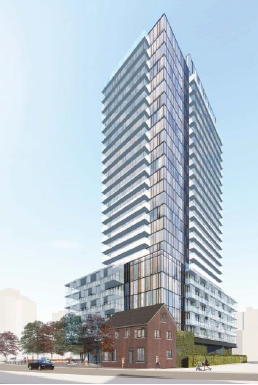 This is what the CORE development group is proposing; the heritage building will continue as a restaurant; traffic will flow on to Lakeshore Road the other side of this rendering. Two people from Urban Design headed up the presenting – they were professional and polished and they gave it their best shot. It didn’t appear to be enough to move this council.
Lisa Kearns, the Councillor for Ward 2 made it very clear that she would not support the development.
Mayor Marianne Meed Ward reminded the meeting that she was holding the football property to no more than eight storeys – and would go up to 15 if there were significant benefits for the public – which to her way of thinking was much more land for public use.
During the presentation the architect was brought up to explain what was sustainable about the site. He said the building would be heated and cooled geothermically – the equipment would be put in by a firm they owned.
The traffic expert came up to the podium to clarify just where the cars would get out of the 27 storey building that would have four floors of underground parking. Believe it or not they plan on having traffic in and out on Lakeshore Road. Keep in mind that the Nautique development will be on the other side of the road – almost directly across from the CORE development.
When asked what would the Chrysler Carriage House be used for the meeting was told it would be commercial and that they would probably use it as a restaurant location.
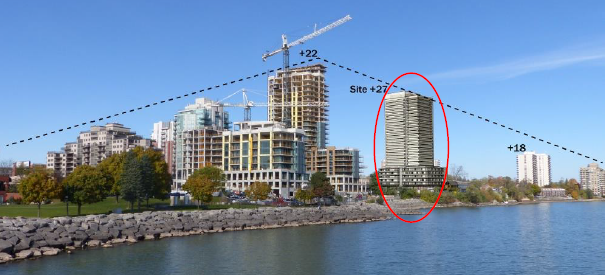 Someone has finally come up with a reason for building the Pier – it was that “iconic” location from which people could see the city skyline and point out all the tall buildings. There is a word for that kind of traffic flow – wondering what the Transportation department will have to say when the project gets to them?
Bryan Nykoliation, who was introduced as the development owner (which he isn’t) was asked by the Mayor if he would withdraw the development until such time as the city has completed the study it intends to do once the review and refinement of the adopted but not yet approved Official Plan work is completed. Nykoliation said he would not do that.
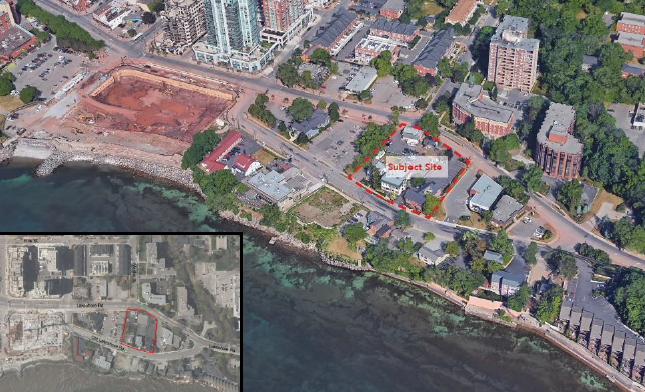 The western edge of the development lines up with Martha Street Their design consultant said she believed the CORE group had a very strong argument justifying the location and the building her client wanted to build.
A large part of the presentation was on how the proposed development fit into that part of the Lakeshore community. The design consultants used the existence of the under construction Bridgewater project and the approved ADI Nautique development as their view on what was to come and how their development fit into the bigger picture as they saw it.
 The developer argued that they weren’t adding anything to the skyline that wasn’t already there. 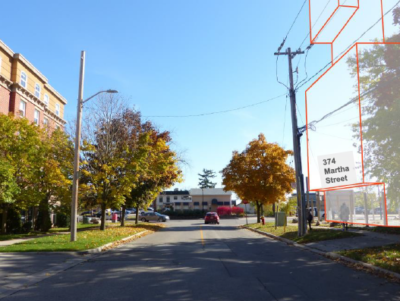 The outline on the right is the ADI Nautique structure. Lakeshore Road is in the middle with Emma’s on the other side. The CORE development would block the view of Emmas. They provided illustrations showing that there project wasn’t going to be any bigger than anyone else’s. They have illustrations of view from the Pier and an illustration that purported to show that the view from Martha street looking south to the lake left people with a clear view. They didn’t include Emmas Back Porch in the illustration.
The event was one of the more boisterous Statutory meetings we have seen in some time. The developers have been meeting with the Planning department people for some time; they left the impression that the planners are comfortable with the development. Consultants get paid to do that.
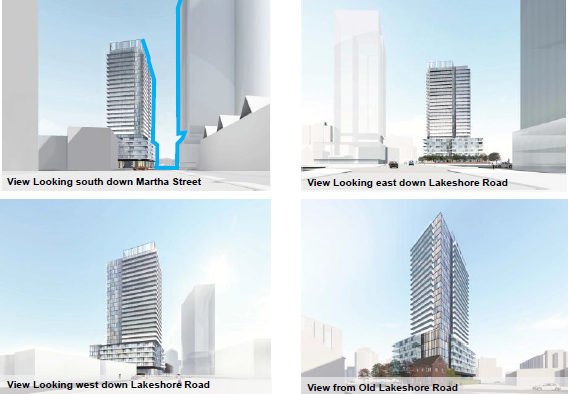 Views on what the development will look like from different locations. 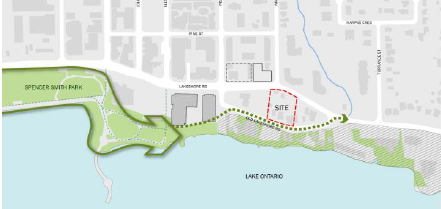 The consultants took the position that there development was, to some degree, an extension of Spencer Smith Park There will be a wide public path at the edge of the lake behind the Bridgewater that leads up to Old Lakeshore Road. Making the case that it is an extension depends on what gets built on the western end of the “football” 
 By Pepper Parr By Pepper Parr
October 31st, 2019
BURLINGTON, ON
This is the second of a six part series on how the city is revising the adopted but not yet approved city plan.
The Taking a Closer look report was prepared by SGL, a consulting group and delivered to the city last August.
The public didn’t become aware of the document until earlier this week. So much for “meaningful engagement”.
The report is the first step in the re-examination of the Official Plan. It is intended to provide a guide to the background to the City’s Official Plan (OP) Policies for the Downtown and the process the City is currently undertaking to re-examine the Downtown OP Policies.
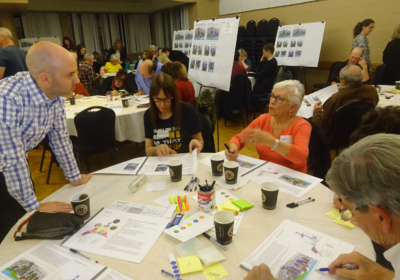 Planning Staff met with citizens during an Action Plan meeting where the participants had workbooks to record their thoughts. A companion piece to this report is the Public Engagement Plan. It provides a roadmap of the engagement activities that were to take place over the next few months, highlighting at which points in the process engagement will take place, who will be engaged and the level of engagement. The plan also clearly defines which aspects of the process the City and public can influence throughout the discussion.
On February 7, 2019 the new City Council voted to re-examine the policies in the adopted Official Plan. The Council motion directs Burlington’s Director of City Building to commence a process to re-examine the policies of the Official Plan in their entirety as they relate to matters of height and intensity and conformity with provincial density targets.
A Council workshop was held on March 18, 2019 to obtain further Council feedback on this direction. Council’s further feedback resulted in focusing the work on the Downtown and on refinements to the Neighbourhood Centres policies.
A work plan for re-examining the Official Plan policies was presented by City Staff to Planning and Development Committee on May 21, 2019 and approved on May 27, 2019.
The outcome of this work will be a set of modified policies for the Downtown supported by a Final Report prepared by SGL – the consulting firm the city hired to produce the study and manage a large part of the public engagement.
It is amazing how many people do not fully understand what the purpose of an Official Plan is; what it does and how it gets revised.
An Official Plan is a statutory document that describes the City’s long-term, land-use strategy for the next 20 years. It is prepared with input from the public and helps to ensure future planning and development will meet the specific needs of the community.
An official plan deals mainly with issues such as:
• the location and form of new housing, industry, offices and shops;
• the anticipated needs for services such as roads, watermains, sewers, parks, schools and community amenities;
• where future growth will happen in the City and how to make effective use of land;
• opportunities for community improvement initiatives; and
• community identity, place-making and urban design.
The over-rising issue during the October 2018 municipal election was the matter of height – and where the tall buildings would be located. Most people did not object to tall 25 storeys + buildings – they just didn’t want them in the downtown core – south of Caroline. At this point in time the citizens are looking at three that have been approved (one has shovels in the ground) with three others working their way towards the planners at city hall.
 Once they were sworn in they got down to business – the day after this was taken they fired the city manager. An Official Plan is typically intended to plan for a 20-year time frame but could provide direction beyond that time period. The Re-examination of the OP is intended to guide planning to 2031.
The Official Plan Burlington is working under today was approved in 2006.
The City commenced an Official Plan Review in 2011. The review included preparation of numerous studies, analysis and public engagement over an 8 year period including preparation of a Mobility Hubs Opportunities and Constraints Study, Employment Land Studies, and a Commercial Strategy Study. This review was intended to conform with and implement the Region’s Official Plan and conform to the new Growth Plan for the Greater Golden Horseshoe.
This is how we got to where we are. The next installment is about the process being used.
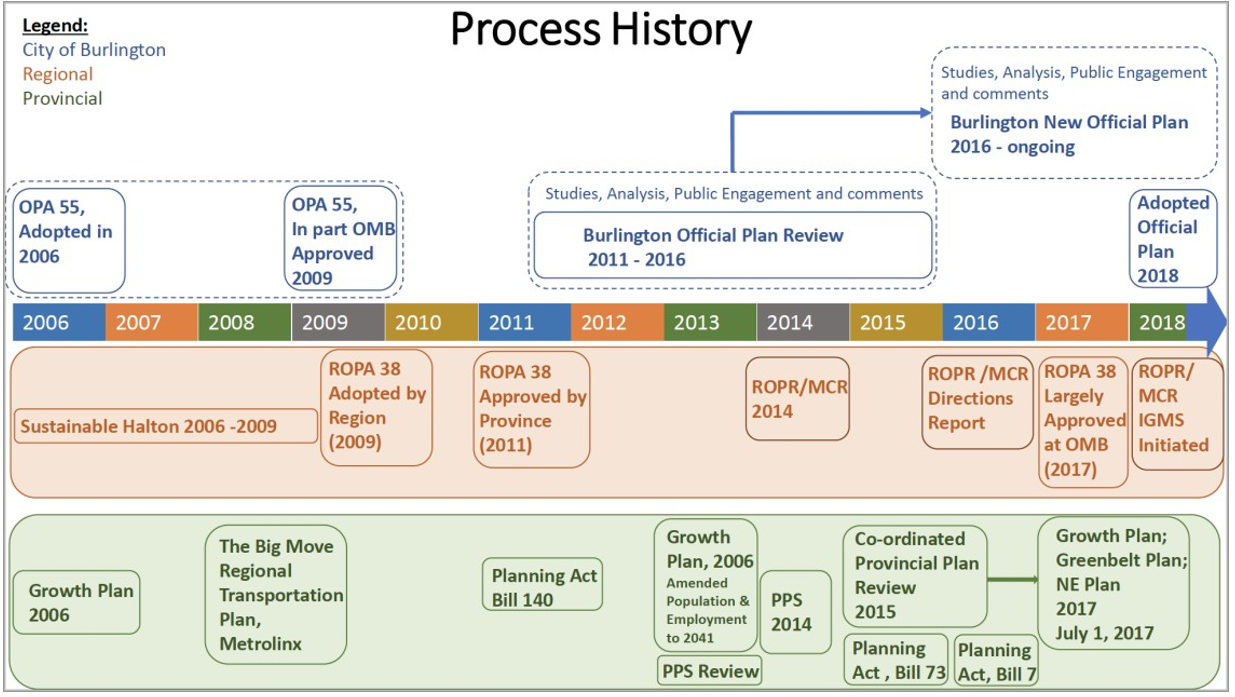 How we got to where we are – it is not a pretty picture. Mobility hubs were to be one of the planning approaches Burlington would use to accommodate the growth that was to take place.
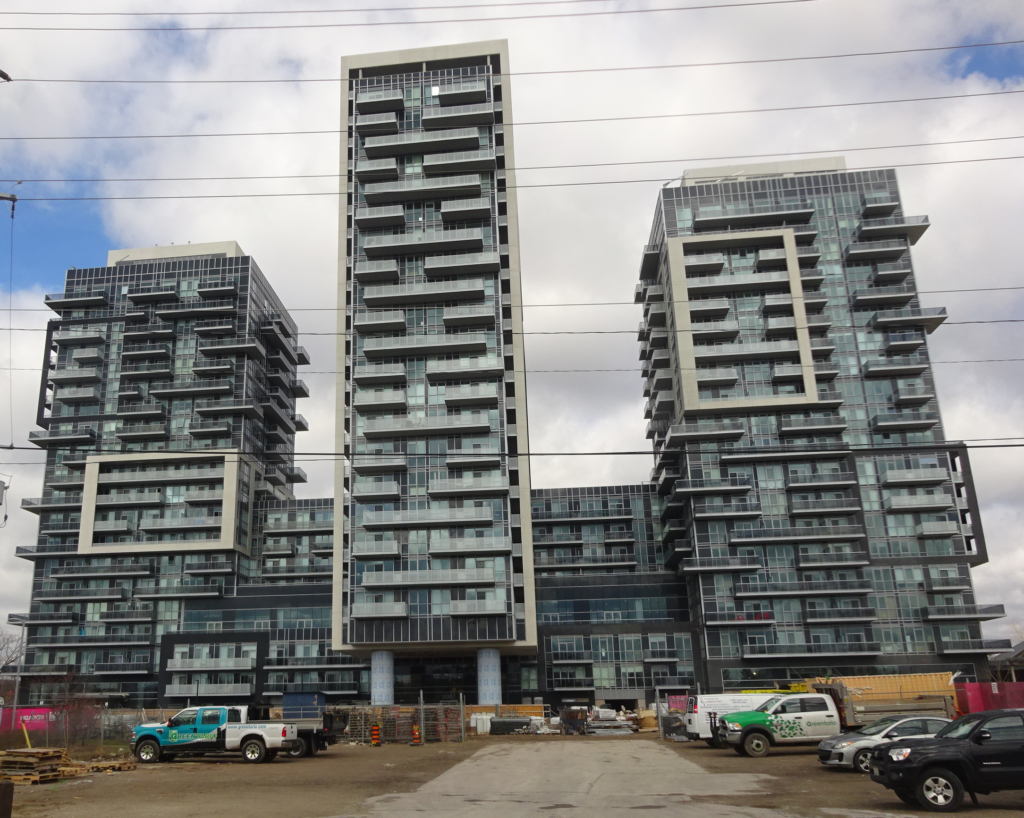 The Molinaro Group were the first to develop around a GO station – one of the three mobility hubs in Burlington. A Mobility Hub, as defined by Metrolinx, is a major transit station area that has the potential to accommodate a range of employment, housing, recreation and shopping around it. Mobility Hubs are intended to be mixed-use neighbourhoods that are walkable, bikeable and transit-oriented and to be a focus for intensification. The Hubs will also take advantage of Metrolinx’s planned Regional Express Rail, which will feature two-way, all-day service every 15 minutes along the Lakeshore West line. The four areas included in the Mobility Hubs Study were Aldershot, Burlington, and Appleby GO Stations, as well as Downtown Burlington.
A major transit station area (MTSA) is an area around a higher order transit station or the area around a bus depot in an urban core or downtown. Higher order transit includes subways, GO lines, streetcars and buses in dedicated rights of way. An MTSA is generally the area within a 10-minute walk (500 to 800 metres) of the transit stations. However, the Region is required to delineate the specific boundary of the MTSA, which will be done as part of their current Official Plan review. Lands within an MTSA are required to provide a diverse mix of uses, support transit, be a focus for growth, and in certain cases achieve a minimum density.
The Halton Region Official Plan recommends that Mobility Hubs receive a higher level of development intensity and design consideration to support transit than what may be applied in other MTSAs.
Following the identification of Mobility Hubs by Metrolinx, the City’s long term 2015 – 2040 Strategic Plan identified the importance of Mobility Hubs near the City’s GO Stations and in the downtown.
 The original view was that there would be four mobility hubs – the one in the downtown core was little more than a bus station. It is expected to be removed from the list. In July 2016, Burlington City Council approved a staff report, which outlined a work plan, allocation of staff resources and required funding to simultaneously develop four Area Specific Plans, one for each of Burlington’s Mobility Hubs. An Area Specific Plan, also sometimes called a Secondary Plan, is a plan that is more detailed than an Official Plan and guides future development in a specific geographic area. An Area Specific Plan can include a variety of studies and contains specific policies to guide future development.
City Council unanimously approved the project, with the goal of completing all four Area Specific Plans no later than June 2018. In April 2017, the Mobility Hubs Team began a comprehensive public consultation program around the future vision for each of the Mobility Hubs as shown in the timeline for the Downtown Mobility Hub work.
 Downtown Mobility Hub Study Timeline. The work on the Mobility hubs was put on hold when the city realized that the number of developments in the downtown core were overwhelming the planning staff and except for the Molinaro Group and the Adi Development Group, no one was doing anything within the hub boundaries. Staff began working on the Downtown Mobility Hub Area Specific Plan in advance of the other three Mobility Hubs with the objective of including a vision for the downtown in the draft New Official Plan in late 2017. The New Official Plan provided an opportunity to strengthen the existing policy framework for the downtown.
The boundary for the Downtown Mobility Hub included both the existing “Downtown Mixed Use Centre” boundary in the current Official Plan as well as the Urban Growth Centre (UGC) boundary. The Downtown Area Specific Plan was developed with a long term, full build-out perspective which extended well beyond 2031.
The City of Burlington Official Plan 2018 was adopted by Burlington City Council on April 26, 2018.
A new city council was sworn in on December 3rd, 2018.
On December 4, 2018, the Region of Halton provided a notice to the City advising that the adopted Official Plan does not conform with the Regional Official Plan in a number of respects including issues related to agricultural, employment, transportation and natural heritage. The Region did not identify any issues of conformity with the Downtown Precinct policies.
The Region informed the City that the City can make additional modifications before the plan is approved by the Region with appropriate planning justification and public consultation. Today, the adopted Official Plan is still under review by the Region for regional approval.
City Council together with the direction to re-examine the Official Plan also passed an Interim Control By-law (ICBL) and put the Mobility Hub Area Specific Planning on hold.
Part 1
Next installment: The Process.

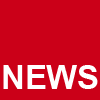 By Pepper Parr By Pepper Parr
October 30th, 2019
BURLINGTON, ON
This is the first of a six part series on how the city is revising the adopted but not yet approved city plan.
It doesn’t carry the same weight as the Shape Burlington report but if we don’t manage what the Taking a Closer Look at the Downtown: What You Need to Know report sets out – there won’t be all that much left of the shape people who voted for the new city council wanted.
The report is lengthy and we aren’t going to set it all out for you in a single document. What we are going to do is publish the report in six pieces based on table of contents which read as follows.
Introduction
What is the Purpose of this Report?
Why is the City Re-examining the Adopted Official Plan?
What is the Purpose of an Official Plan?
How Did We Get Here?
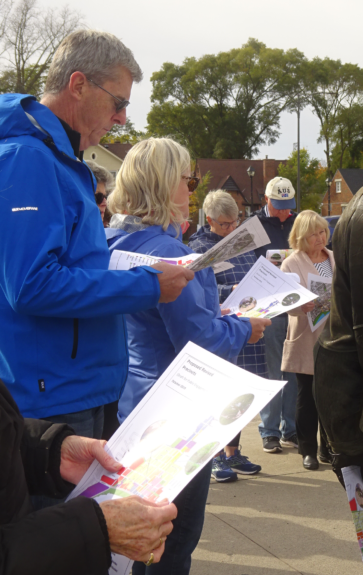 People who took part in the Walking Tour looking over the map. The Process
What were the Objectives of the Downtown Precinct Plan?
What Public Events were Held During the Official Plan Process?
What did the City Hear During the Official Plan Process?
What is Involved in Re-Examining the Downtown Policies?
Governing Policies and their Role in the Outcome
What is The Provincial Policy Statement?
What is A Place to Grow, Growth Plan for the Greater Golden Horseshoe?
How does the Halton Region Official Plan Guide Planning in the Downtown?
What is the City’s Vision in the Adopted Official Plan?
What are the Key Policy Directions that Influence the Downtown?
Connections to Other Projects
What is the Timing of the Region’s Official Plan Review?
What’s the Status of the Area Specific Plan for the Downtown Mobility Hub?
What is an Interim Control By-Law?
What is an Interim Control By-Law?
The Engagement Plan and What You Should Know
What is an Engagement Plan?
What Does Meaningful Engagement Look Like?
What Does Meaningful Feedback/Input Look Like?
What You Should Know to get Involved
The work being done on the adopted but not yet approved Official Plan is referred to as a Scoped Re-examination. The next step is to finalize the background technical studies that were initiated during the Mobility Hub Area Specific Planning Study including, but not limited to, studies on cultural heritage, municipal servicing and transportation.
We will use these themes to guide the creation of two land-use and built form concepts for the downtown. We will also use the themes and principles developed with the public to create evaluation criteria, which will be used to evaluate the two concepts.
We will then share the two land-use and built form concepts to start a discussion with the public. Based on public and technical inputs and application of the evaluation criteria, a recommended concept will be developed and presented to Council for endorsement.
The concept endorsed by Council will be used to refine the Downtown Precinct Plan policies in the adopted Official Plan. Those refined policies will in turn be presented to Council for endorsement. The concept and policies endorsed by Council will then be sent to Halton Region for final approval.

The report was released to the public today – unfortunately it wasn’t given to the 150 people who took part in the Action Plan Workshops, nor was a copy given to the 40 some people who took part in the Walking Tour.
That was regrettable.
The Taking a Closer Look at the Downtown: What You Need to Know report is the first step in the re-examination of the Official Plan; it is intended to provide you with a guide to the background to the City’s Official Plan (OP) Policies for the Downtown and the process the City is currently undertaking to re-examine the Downtown OP Policies.

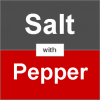 By Pepper Parr By Pepper Parr
October 29th, 2019
BURLINGTON, ON
 The land between Lakeshore Road and Old Lakeshore Road has been referred to as the football every since we started publishing. Why would the city want to name is the peanut? Is it a football or a peanut?
What most people know as the “football” was referred to as the peanut by Director of Planning Heather MacDonald at one of the Action Plan sessions last week.
 Is it a football …. 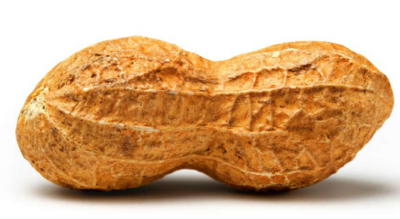 …or a peanut? It is probably the most significant piece of developable land left in the downtown core.
In time it might equal Spencer Smith Park in importance to the look, feel and public open space in the city.
Right now there are developers crawling all over the land with proposal for developments that will rise more than 25 storeys.
The Carriage Gate Group subsidiary Lakeshore Old Burlington gave a presentation to a very small group at a public meeting recently. No one has yet to explain why that meeting was so poorly promoted.
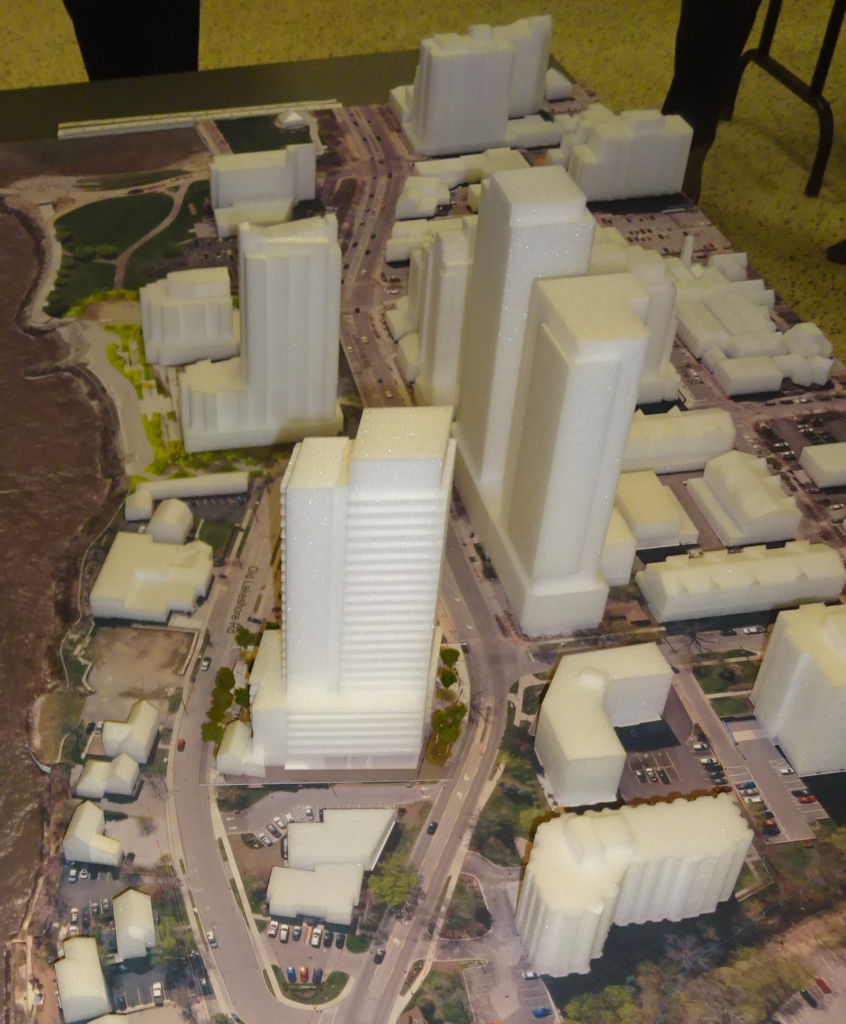 Not much of that quaint, walk-able community in this 3d model of what the CORE Development group want to dump into the ‘football’. The CORE Development group gave the public a good look at what they have in mind for the properties to the west of the Burlington Old LAkeshore proposal.
They will be making the required Statutory presentation to city council on November 5th at city hall
 Lakeshore Mixed use precinct – on the north and south side of Lakeshore from Locust to Martha. Each property will have its own rules put in place. During the two Action Plan workshops the city held for residents some people wanted to know why the “football” and the Lakeshore Precinct were not included in the public think sessions.
They were told by the Director of Planning, Heather MacDonald that those precincts were to be the subject of separate studies once the revisions to the adopted but not yet approved Official Plan are in place.
One can sympathize with the workload the Planning department faces but the “football” and what has been defined as the Lakeshore precinct are just as important as the look and feel of Brant Street if not more so.
What makes Burlington the city it is – is the lake.
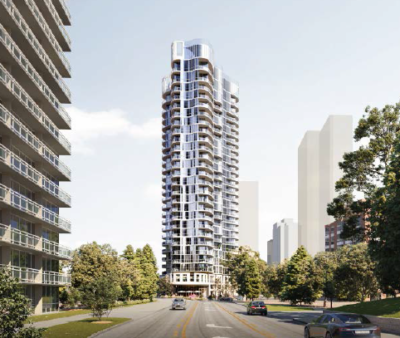 At the eastern edge of the football – the tower will become the gateway to the downtown core. 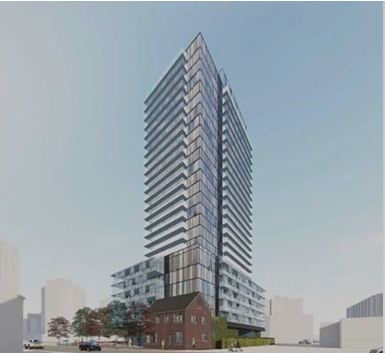 This structure is to the immediate west of the latest Carriage Gate Development.
The millions spent on the Pier; the millions spent on getting public access to the lake at the foot of the Bridgewater development and public access to the lake through that development will be for naught if there are no rules that apply to the football and the Lakeshore precinct.
At this point there are two mammoth development applications for the “football” on the table
Let us not repeat the terrible mistake with that Anchor Hub – the label that got stuck on a tiny bus terminal.
Related news stories:
The stunning development planned for the “football”
Can high rise development be brought to an end?

 By Pepper Parr By Pepper Parr
October 28th, 2019
BURLINGTON, ON
There are mobility hubs
There are anchor hubs
There are MTSA’s – Major Transit Station Areas
There are urban growth centers.
They are all tied together but not all that well understood.
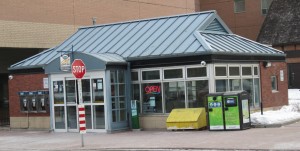 We know it as the bus terminal – the bureaucrats call it an Anchor Hub; a developer saw it as a great stroke of luck. 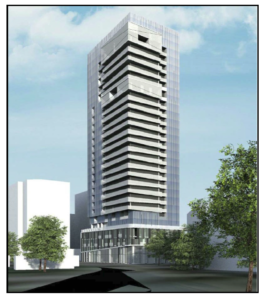 A bus terminal made the height of this development possible. One of them, the Anchor hub that had been proposed for what most people know as the bus terminal on John Street, put the city in a position where they could not deny a developer the right to put up a building – which really screwed up the plans the city had for property on Lakeshore Road close to where it meets up with Old Lakeshore Road. The developer used the existence of an Anchor hub as justification for the high rise.
The Anchor hub is basically a small bus depot that at one point was to be torn down.
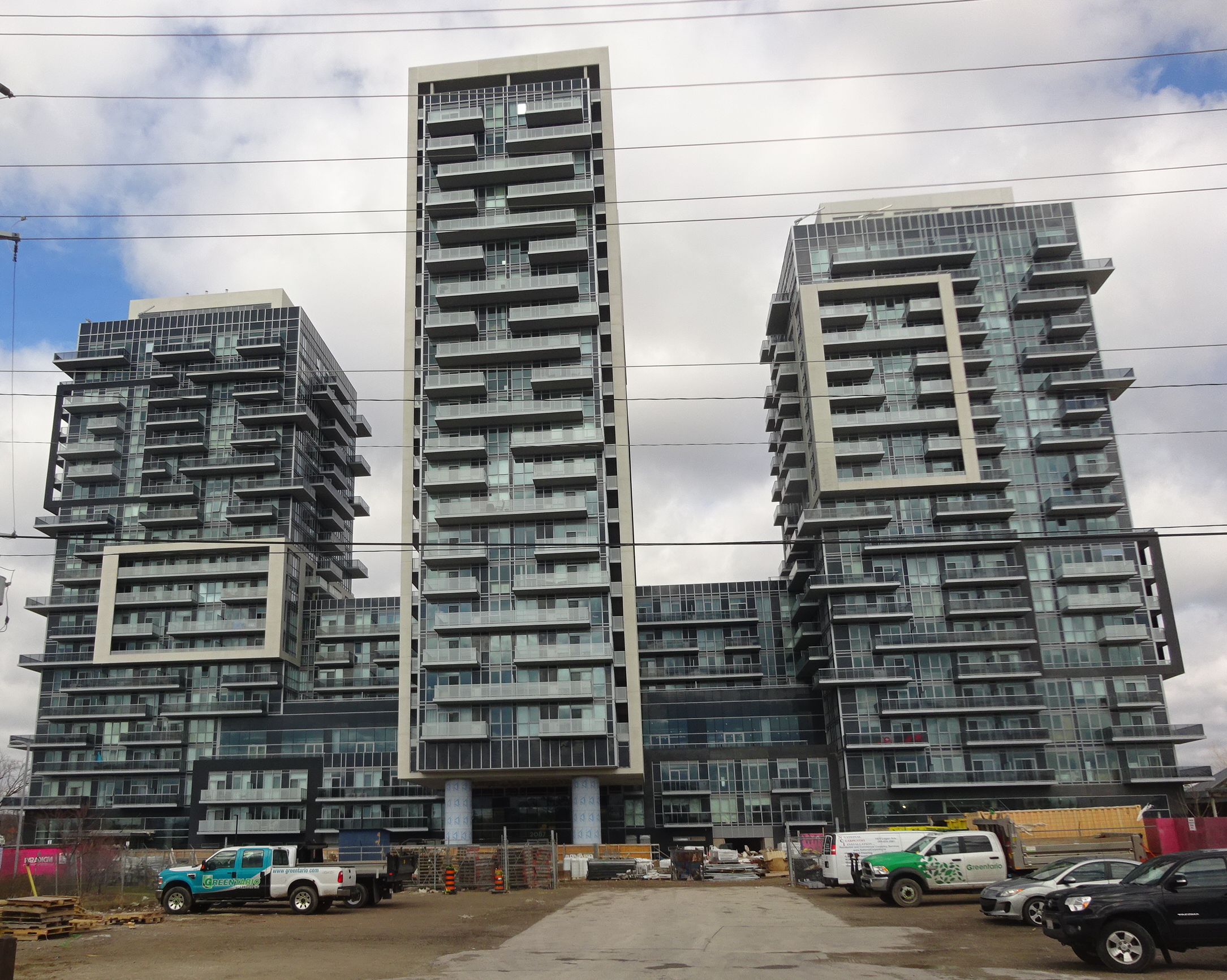 Three of the five towers that make up the Paradigm development on the north side of Fairview right next to the GO Station. The Mobility Hubs are clustered around the GO stations where the developers have bought up as much of the and as possible. The Molinaro Group was ahead of the development crowd when they broke ground for the Paradigm development – five towers snuggled up beside the Burlington GO station.
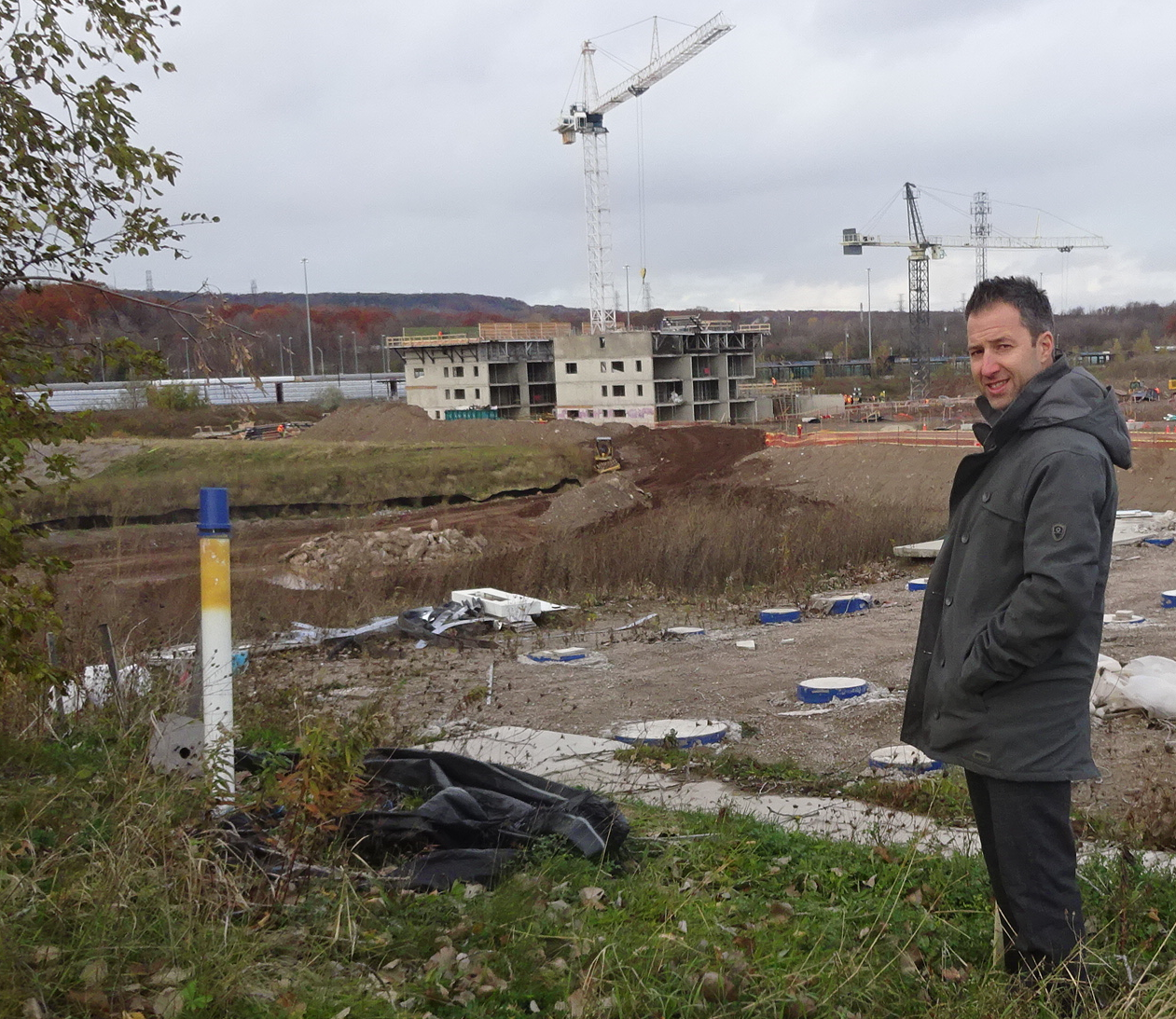 Adi Developments Station West in the early development stage. Councillor Kelvin Galbraith has a number of major developments taking place in the western end of the ward that will increase GO train traffic. The Aldershot GO station area has a very large two stage ADI development underway.
Nothing in the works yet for the Mobility hub that will be part of the Appleby GO station.
There isn’t all that much controversy around the Mobility hubs – although Dr. Shie would like to see the eastern edge of the Burlington GO hub moved to the east – to the other side of Guelph line so that it includes the property at Guelph and Harvester Road.
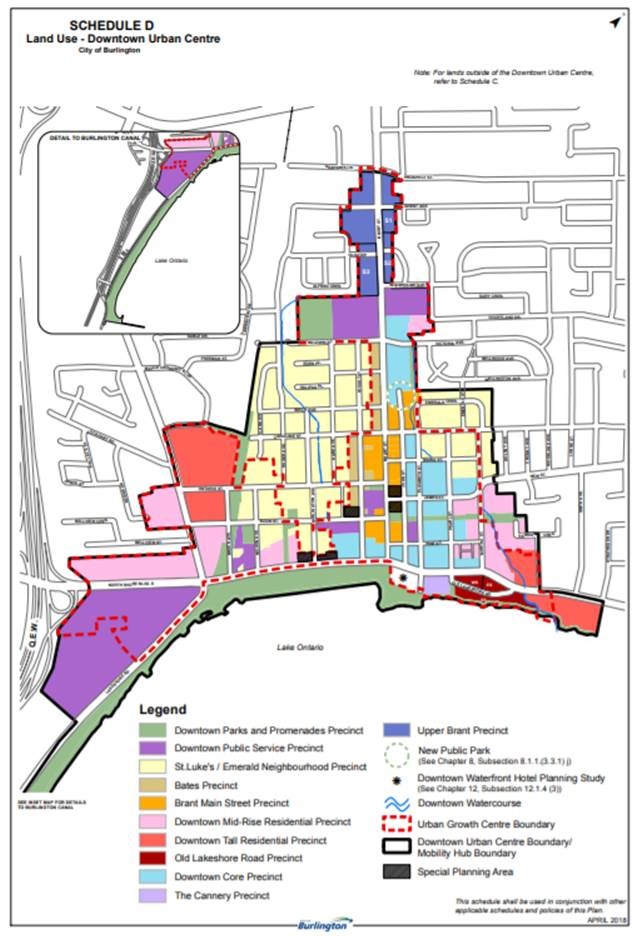 The boundaries of the Urban Growth Centre that the province required every municipality to have. Many now believe that the location chosen and the boundaries put in place need to be changed. The Urban Growth Centre is something the city had to create. That was a provincial requirement. The city had to have one – but it had some influence on where it would be located and what the boundaries are. The current UGC boundary is a little too far to the south for many people.
It was created in 2006 – many think both the location and the boundary lines were a mistake. Members of the current council have come to believe that the location of the current UGC can be moved and the boundary changed.
You had to have one but you get to determine where it will be located.
The Anchor isn’t a gotta have. The story we got from Councillor Lisa Kearns is that the city will get rid of the Anchor Hub (bus station) just as soon as the Interim Control Bylaw is lifted – which is expected to happen in March of 2020.
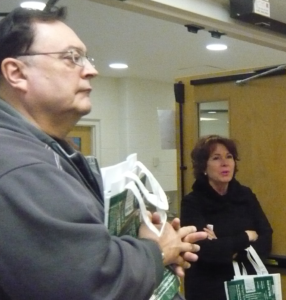 Burlington MPP Jane McKenna stuck her head in the door, didn’t like the look of the meeting and left. Getting the location and boundary of the Urban Growth Centre is not as easy. Kearns told the Gazette that the members of the provincial government: Jane McKenna, Burlington and Effie Triantafilopoulos, Oakville North Burlington will be drawn into the discussions.
Triantafilopoulos understands the complexity of the issue and is for the most part approachable and works at having good, strong working relationships with her peers.
Many residents have not had the same experience with McKenna.
It will be interesting to see how this work out. We weren’t able to get much in the way of a sense as to how long this will take from Councillor Kearns.

 By Pepper Parr By Pepper Parr
October 24th, 2019
BURLINGTON, ON
The city council in place now looks at technology a lot differently than the council that served from 2010 to 2018.
That cohort was not comfortable with technology, were unable to make it work for them and didn’t know how to direct staff to make it work for the citizens.
The new council has members that know a lot more than many of the people in the IT departments. Lisa Kerns will rattle off data and phrases that most people don’t quite get. Part of it is some showing off – but she usually knows what she is talking about.
Getting information into the hands of the public, at least for those who want to know the what and why of what’s happening, is easily done if good data applications are put in place.
There is now a source of almost everything you might want to know about developments taking place in the city.
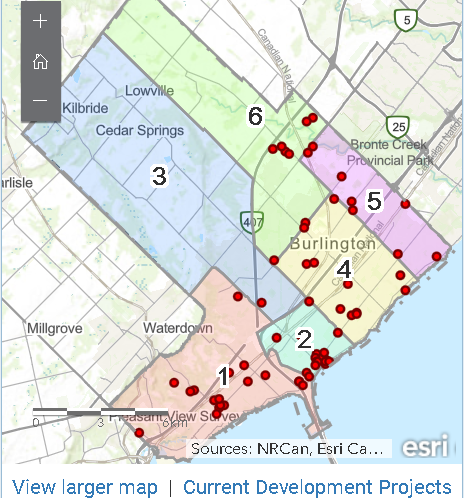 You can adjust the size of the map. You can adjust the size of the map.
Then by clicking on on any one of the red dots you get a short summary of who is doing the development and links to the city’s planning department which then gives you a list of all the studies that were done.
There is also a link to the developers web site.
Most of what you need is at your finger tips – no more scooting around from place to place to gather information on a single development.
A good step forward..
Try it – the Development sites is part of the Get Involved city web site.
Link:

 By Pepper Parr By Pepper Parr
October 24th, 2019
BURLINGTON, ON
The people in the planning department and those in communications were about to learn if they had put together a program that would bridge the gap between what was planned and what was actually achieved.
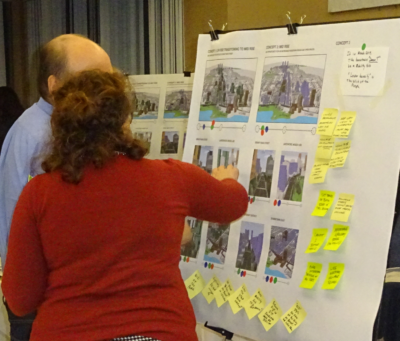 Each of the yellow “notes” were an idea, a comment that would be reviewed by planning staff. 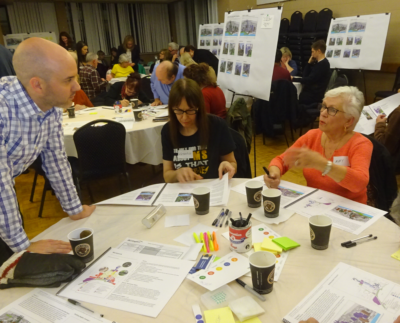 Planning staff floated through the room ready to answer questions. There were a lot of questions. It was complex.
The city has an Official Plan, it is required to have an Official Plan and it is required to update that Plan.
In 2018 the city approved an Official Plan and sent it off to the Region.
City plans have to comply with the Regional Official Plan.
That plan got called the “approved” Official Plan.
Then the city held an election and a new council was in place along with a new Mayor who believes she was elected to make some changes.
 Each red dot is a development proposal – the planning department couldn’t keep up with the applications. Development applications were being submitted to the Planning department at a brutal rate. Staff could not keep up with the volume but the rules of the planning game are that anything that is submitted to the Planning department has to be considered.
The city needed to put a halt or at least slow down the rate at which development applications were being submitted.
They imposed an Interim Control Bylaw (ICBL) which put a halt to the approval of any new developments within a specific area. That area was defined as the Urban Growth Centre.
The new city council and the new Mayor then directed Staff to re-write the “approved” Official Plan and ensure that there was plenty of opportunity for public input.
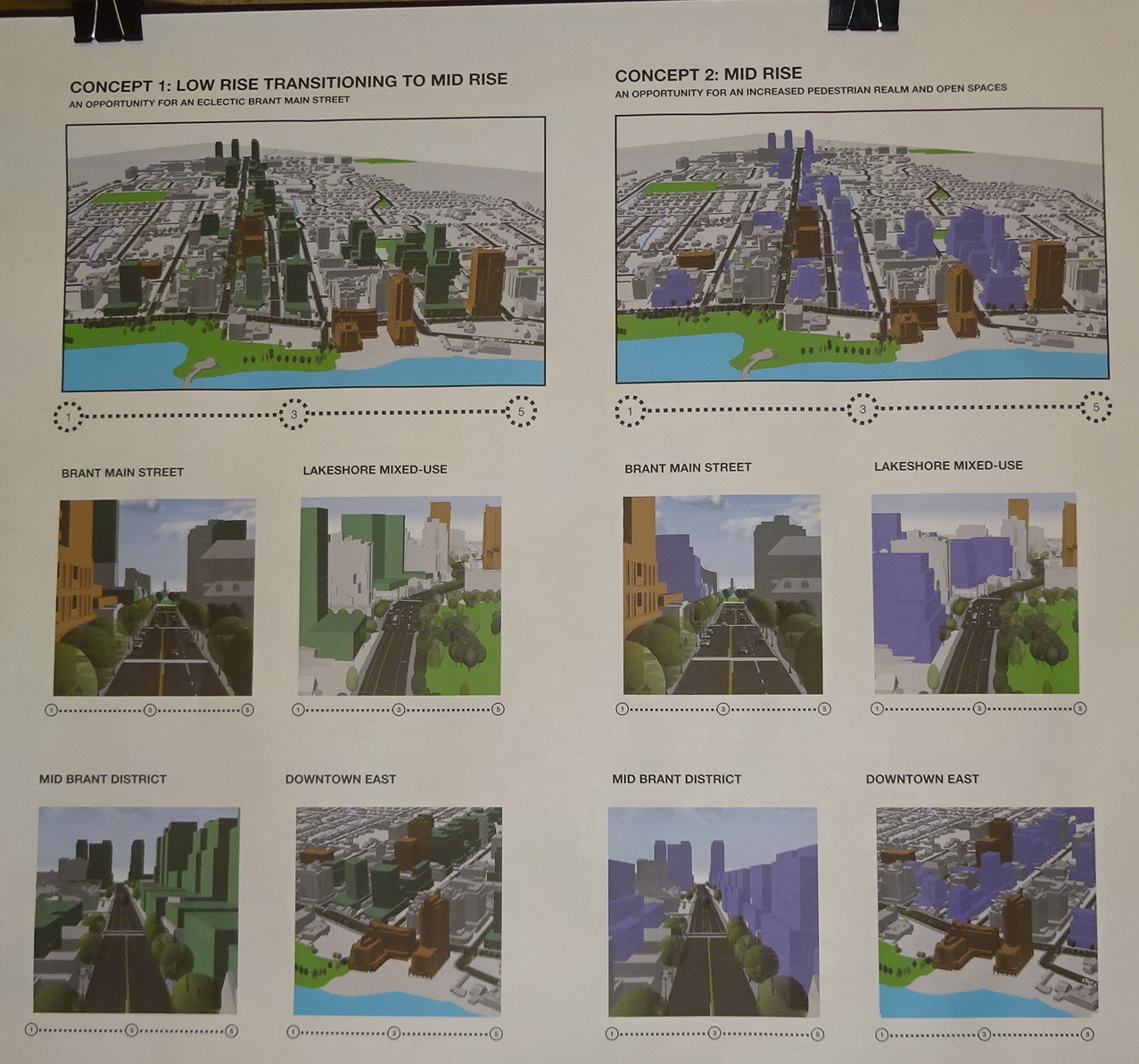 The audience was given choices that the consultants said could be revised, added to or merged with other ideas. There was nothing that couldn’t be out on the table. That is what got 75 people at an Action Plan meeting last night at the Lions Club Wednesday evening plus another 75 people for an afternoon meeting – to look at what the city had collected in the way of information and ideas at a meeting that took place in August.
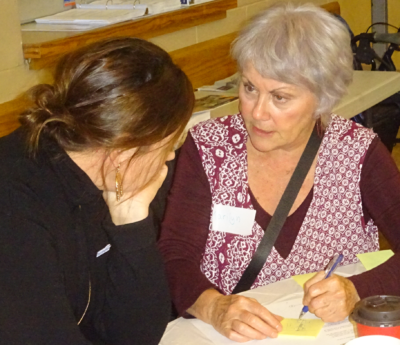 Lisa Kearns, on the left, the ward Councillor in discussion with a resident. 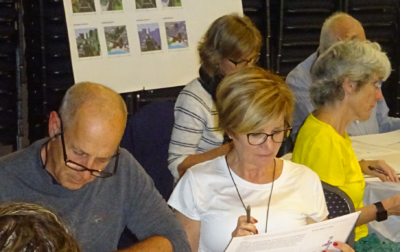 Couples worked diligently on the documents they were given and asked challenging questions throughout the evening. There was criteria, there were principles, there were precincts and there were ideas – they called them concepts that they wanted the public to look at, debate, discuss and provide whatever was on their minds as feedback to the planners and the consultants.
The afternoon and evening sessions of the Action Plan meetings were considerably different. The Gazette did not attend the afternoon session, which we were told worked quite well.
The people at the evening session kept going off script – they had all kinds of questions that were not directly related to what the facilitators were trying to get across.
 Planner Allison Enns with Director of Planning Heather MacDonald on the right. On two occasions the Director of Planning had to go to the front of the room and quietly explain some of the decisions that were being made.
The evening session wanted to know why the Waterfront Hotel property was not being included in the discussions –same with what has come to be known as the “football”, that property between Lakeshore Road and Old Lakeshore Road that has to 24 storeys plus application in the hands of the planners.
There were very some pretty sound reasons for not including those two pieces of land. It wasn’t at all certain that the audience understood just what those reasons were.
It was a solid two and a half hours of people who care about their city and do not want to see the downtown core become a collection of high rise towers with nothing but wind tunnels at the street level.

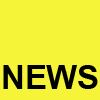 By Pepper Parr By Pepper Parr
October 23rd, 2019
BURLINGTON, ON
This article has been revised to include comments from ECoB
Last October we elected a new city council. They said they were going to make changes and that they were going to engage you in that process.
They weren’t kidding.
Two views of the downtown core: The first picture is what Burlington once was, the rendering below that is what some people want Burlington to be.
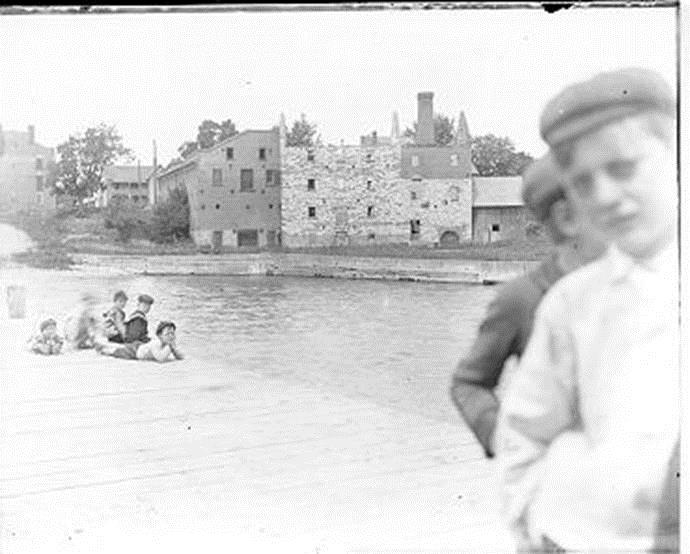 This was the factory at the bottom of Brant street where fruit and vegetables were canned. There aren’t many people around these days who remember the pungent smell of tomatoes being boiled and canned. Below is what some citizens want. 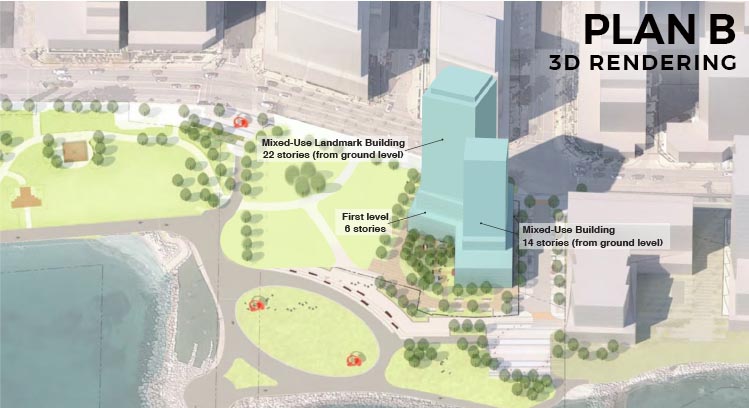 The Waterfront Hotel site is up for re-development. There is a group of citizens who want to see a clear line from the bottom of Brant Street out into the lake with the redeveloped hotel site moves to the east. Today there are two Action Labs at which the city is going to reveal two concepts on what the city might look like in the future.
Both are taking place at the Lions Club at 1pm-3pm & 7pm-9pm.
There is also a Walking Tour – Sat. Oct 26 – 1:30 – 3:30 p.m.
This is part of the Taking a Closer Look at the Downtown exercise.
Tour leaves the No Frills plaza 571 Brant St at 1:30 p.m.
1. See first-hand the areas of downtown that are being looked at as part of the re-examination of the adopted Official Plan
2. Experience what mid and tall rise buildings feel like from the street, when walking through the downtown.
The event has not been all that well promoted. ECoB, the Engaged Citizens of Burlington relased the following information earlier today.
What will happen?
- The city will show two preliminary concepts for the revised Official Plan for Downtown.
- You will be invited to provide feedback via a ‘citizen action lab’ workshop.
- Your feedback will be included in the next stage as a final plan is drawn up for consideration by Council.
The failure of the city to successfully engage with the public on the Official Plan in 2017/18 was a major reason for the creation of Engaged Citizens of Burlington and for the changes on Burlington Council last year.
Is the City Doing Engagement Right This Time?
ECoB has welcomed the improved processes that are being used for public meetings during the process of revisiting the downtown plan.
Nevertheless, we are disappointed that given a year to review the downtown OP, the city is still relying on citizens being able to attend public meetings or visiting city websites to provide comment. We believe it was essential for the city to reach out to residents who traditionally do not or cannot attend public meetings or participate in online questionnaires. A small additional budget for more vigorous public engagement would have helped the city obtain public comment that was statistically relevant and representative of the whole community.
Nevertheless, don’t miss the opportunity to have your say on the draft plans! Make sure your voice is heard!

 By Staff By Staff
October 17th, 2019
BURLINGTON, ON
The push is on.
The city wants some of the political oxygen that we are all breathing.
People are focused on the federal election.
The city wants you to remember that they too play a role in how decisions are made and they want you to take part in that process.
They have all kinds of things lined up for you.
It all starts with a feedback report summarizing what the City heard during the first phase of public engagement for the re-examination of Burlington’s adopted Official Plan; that is now available online at getinvolvedburlington.ca.
What follows is all great stuff – what is worrisome is that an earlier survey drew 308 responses from a city with a population of over 175,000 people.
 Earlier this year, Burlington City Council directed City staff to re-examine the downtown policies in Burlington’s adopted Official Plan, including the height and density of buildings. As part of this work, the City hosted a series of public engagement opportunities in August and September, designed to give the community the chance to provide meaningful input on the community’s vision for the downtown, both online and in person. Earlier this year, Burlington City Council directed City staff to re-examine the downtown policies in Burlington’s adopted Official Plan, including the height and density of buildings. As part of this work, the City hosted a series of public engagement opportunities in August and September, designed to give the community the chance to provide meaningful input on the community’s vision for the downtown, both online and in person.
Participants in the engagement were asked questions about the downtown, including what matters most to them; what they like and dislike; what they want to see protected as the downtown continues to grow; and what they want to see more of in the downtown, through the following engagement opportunities:
• Action Labs – two workshops open to the public where approximately 70 people worked together to discuss, identify and prioritize what is most important to them about the downtown
• Pop-up events – 17 pop-ups events across the community where City staff interacted with hundreds of residents from all wards
• Survey – a total of 308 responses were received online and by hard copy. Working with the Halton Multicultural Council, the survey was translated into five languages, including Arabic, Simplified Chinese, Punjabi, Spanish and Tagalog.
What matters most about downtown: What we heard
From the feedback gathered, the themes heard most often from participants included:
• Keep and attract new businesses
 Plan B hasn’t gotten much in the way of attention lately – it is a citizen led initiative to ensure that when the Waterfront Hotel is torn down and replaced that whatever is built keeps a clear view from Brant Street out to the Pier. The city has never shown much enthusiasm for the idea. • Protect and enhance existing green spaces, strengthen connections to the waterfront, and plant more trees
• Enhance downtown’s role as a year-round cultural, tourism, shopping, leisure and event destination
• Housing options and affordability
• Enhance pedestrian spaces and provide more transit and cycling options, and reduce congestion
• Mid and low-rise buildings preferred in many areas
 These are the storefronts on Brant Street, opposite city hall that will disappear when the development for the area begins construction. A height of 17 storey has been approved – the developer wants 23 – identical to the property to the north on the other side of James Street. • Maintain the small-town charm and preserve heritage
• Safer, more usable, inclusive public spaces
• Appropriate parking supply.
How will the feedback be used?
The feedback gathered in August and September is being used to develop two concepts of what the downtown could look like in the future. These concepts will be shared with the public for further review and input starting the week of Oct. 21. Feedback gathered in the second phase of the public engagement will inform a revised downtown concept, presented as a recommendation to Burlington City Council in January 2020.
More public engagement – Phase 2, starts the week of Oct. 21
To create policies that reflect the community’s vision for the downtown, the City of Burlington needs to hear from as many people as possible. Please consider lending your voice at one of the upcoming public engagement opportunities:
• Week of Oct. 21, go online to getinvolvedburlington.ca to view the two concepts of what the downtown could look like, reflecting the priorities the City heard in the first round of engagement
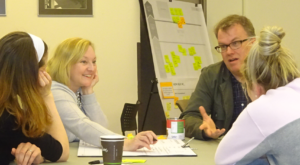 Action Lab participants in one of the early sessions. • Action Labs
Working in small groups, discuss and identify what you like and don’t like about the two downtown concepts. Action Labs will be held on:
• Wednesday, Oct. 23, 1 to 3 p.m. or 7 to 9 p.m. at the Lions Club, 471 Pearl St.
• Saturday, Nov. 2, 1 to 3 p.m. at Mountainside Recreation Centre, 2205 Mt. Forest Dr.
Drop-in, registration not required.
• Downtown Walking Tour
Take a walking tour of downtown Burlington to get a first-hand view of the areas where policies are being re-examined, on Saturday, Oct. 26, from 1:30 to 3:30 p.m., meeting at the No Frills Plaza at 571 Brant St.
• Online Survey
Go online to share your thoughts about the two downtown concepts at getinvolvedburlington.ca. Survey available starting Wednesday, Oct. 23.
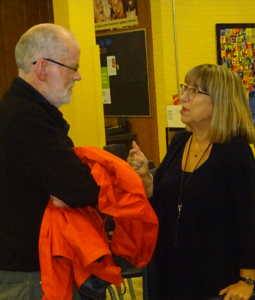 Heather MacDonald, Executive Director of Community Planning, Regulation and Mobility in conversation with Blair Smith. Heather MacDonald, Executive Director of Community Planning, Regulation and Mobility, who is driving much of this public engagement explains where all this is going: “When we set out to re-examine the downtown policies in the adopted Official Plan, one of the objectives we established was to create an ongoing record of the feedback gathered and to report back to the community about what we heard.
“We hope this report is helpful in tracking the progress of the project and in understanding how the input collected may or may not inform the final recommendations to Council.”
“The next key opportunity for public engagement that will directly influence a recommendation to Council starts the week of Oct. 21 and I encourage anyone who cares about the future of the downtown to participate in the conversation.”

 By Staff By Staff
October 11th, 2019
BURLINGTON, ON
There are all kinds of ways to communicate – tweeting being the one that some people can’t stay away from.
A reader who follows all this stuff sent us a tweet with an in depth comment on what can and perhaps cannot be done with the “football” between Lakeshore Road and Old Lakeshore Road.
It is described by another reader as “One of the best comments we have read regarding development and the Downtown Urban Growth Centre. Thank you James, whoever you are. “ There are some suggestions that the James is someone Burlington has experienced.
You can read the viewpoint here.
A thought some might want to ponder: Just how long does one think city hall itself will sit on that land?
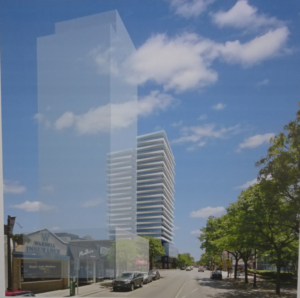 These are the two developments to be built across the street from city hall. The on on the front left is now under construction; the other has been approved for 17 storeys – they want what the other has been approved at 23 storeys. 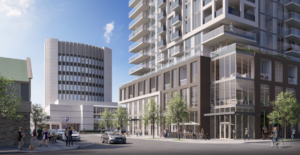 City hall will be dwarfed by the developments on the other side of the street. A former Deputy City Manager described it as “iconic”. 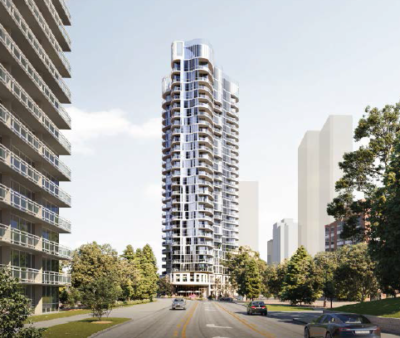 This might well be the view that people have as they enter the downtown core via Lakeshore Road. The building is stunning. Let’s not limit the view to just what can be seen from the upper floors of city hall. The “football” is going to offer some stunning views that might get added to what will be visible right across from city hall.
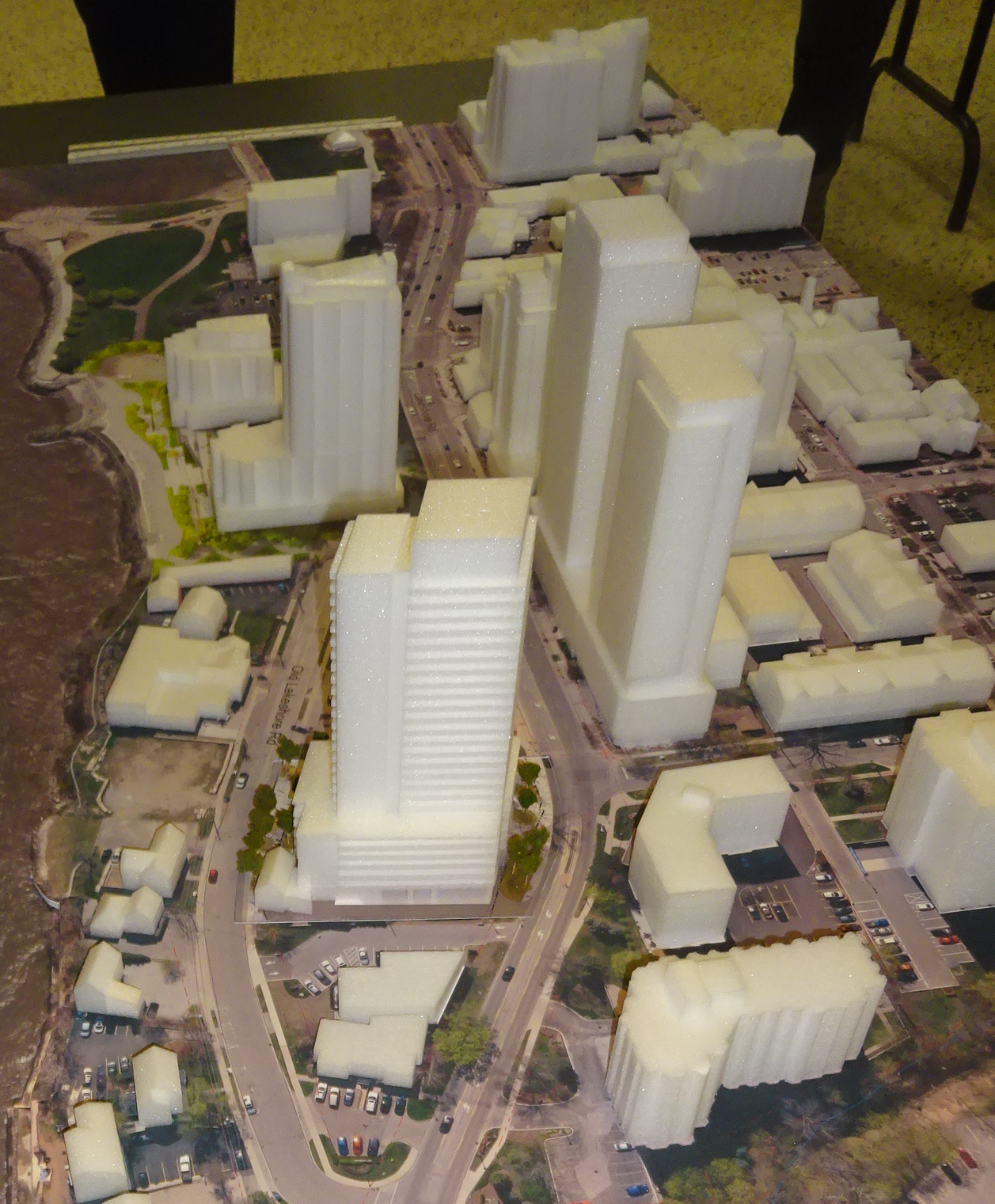 The downtown that some think is Burlington’s future. 
 By Pepper Parr By Pepper Parr
October 9th, 2019
BURLINGTON, ON
The Gazette received the following from the city three days afrer the article appeared.
“I wanted to take the opportunity to provide a clarification to a recent article, https://bit.ly/2q5unMg.
“The article includes a lengthy opinion in which the writer states that City staff had no responses or barely participated in the Local Planning Appeals Tribunal (LPAT) hearing for the proposed development on 92 Plains Road. However, neither the article itself or the opinion make clear that the hearing before the LPAT was a settlement hearing in which the City and the appellant were in agreement on the proposed development and the associated amendments to the City’s planning documents.
“In a settlement hearing, evidence must be provided to the Tribunal to support the settlement. This evidence typically is in the form of the expert opinion of a land use planner from one of the settling parties, as it was in this hearing. The other settling parties, such as the City in this case, do not call further duplicative evidence to support the settlement. It is in hearings where parties such as the City and a developer are not in agreement on the development proposal where the parties call their own witnesses to provide expert opinion, and cross examine opposing witnesses.
“It would be misleading to suggest that because the City did not have its planner provide an expert opinion that she did not act appropriately or that she did not represent the interest of Council’s decision to support the proposed settlement. Rather, the City’s legal counsel made submissions on the appropriateness of the settlement, including in the context of the in-force Official Plan. The LPAT hearing officer will consider the expert evidence provided, along with the submissions of the appellant, the City and the two participants to the hearing, and make a decision in the matter.
“The Notice of Settlement Hearing was also posted on our website, https://www.burlington.ca/en/services-for-you/92-Plains-Road-East.asp so residents could be aware of the hearing.”
If you have heard of LPAT; know what the acronym stands for – read on.
If you don’t – quit now.
LPAT is Local Planning Appeals Tribunal.
It is the level the developers and city can turn to when there is a difference over a development proposal.
Few of the people who follow this stuff have much that is positive to say about the tribunal.
A handful of people chose to sit in on an LPAT hearing at city hall recently.
Tom Muir, one of the types that keeps up to date on this stuff attended – here is what he had to say on what he saw and heard,
I want to provide you with a short briefing on my experience. I have provided you with extended notes and comments on this appeal evidence so I will stick to key points and, as it turned out, a long one page of 13 points.
1. The Lawyer representing the City, David Klacko, and the City Planner, Melissa Morgan, indicated to the LPAT Chair that they would not be presenting any testimony or evidence. Over all, from my perspective over the entire Hearing they might as well have not been there.
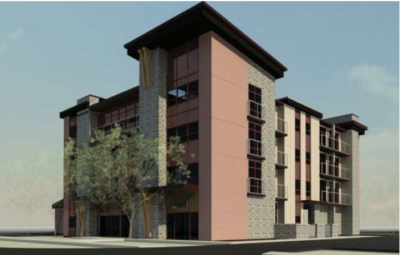 Architectural rendering 2. The Applicant lawyer and Planner disturbed me when they went straight to the adopted Official Plan as the first argument in the Policy Frame supporting the proposal (Item 12 of 112 in the Evidence Outline).
I was further disturbed when the City Lawyer and Planner said nothing at this time about this and as supposed professionals with obligations of disclosure, did not indicate that this adopted OP was not in the City Policy Frame for policy and thinking in this application.
It was only at the very end of the Hearing after all the testimony was done, did the City lawyer say about 20 words to indicate that the adopted OP was not in the City policy frame here, but that the proposal conformed with the in force OP.
3. This indicates that the City agreement with the proposed settlement included agreement that the adopted but not legal OP was on the Table and they agreed to let the applicant Planner use it right from the start – they had the evidence from the applicant lawyer and they had to have agreed to it in order to say they had a settlement. The applicant Planner used an anonymous authority to say that someone at City told him this was the City directions anyways so he used it.
4. This applicant Planner stated that the amendments requested conform with the general policy directions of the new draft Burlington Official Plan (EO 107). He also stated that this adopted OP conforms to the Halton Region Official Plan when this is patently false as the Region did not approve it on the grounds of non-conformity. The applicant lawyer tried to argue that the adopted OP is legal and can be used.
5. Overall, in this Planner testimony, there was a great deal of emphasis on the adopted OP in support of the application and settlement. In this testimony, given under oath, there was a total disregard and no mention for the “shall” or mandatory OP and Zoning policies specific to this site. City staff made no comments. There was no explanation or planning rationale provided for disregarding the “shall” provisions. City staff said nothing.
6. I was given 20 minutes to testify under oath and I raised a large number of issues from this previous testimony and from my own evidence. I will provide only a few of the key issues here. The City Lawyer did not cross examine my testimony.
6. There was applicant Planner disregard to compatibility policies with only 1 criteria mentioned (upper floor setbacks) out of the City policy number of 13. City staff said nothing.
7. Nothing was said or evidence provided about the City policies on intensification adjacent to existing low density neighborhoods. City staff said nothing.
8. There was no evidence or testimony about the City Policies around Urban Design and City Guidelines for Mixed Use and Residential Mid-Rise Buildings. City staff said nothing.
9. These policies are indicated by the City as policies subject to “shall” be done for all proposals. Nothing was said or done by either Party on these.
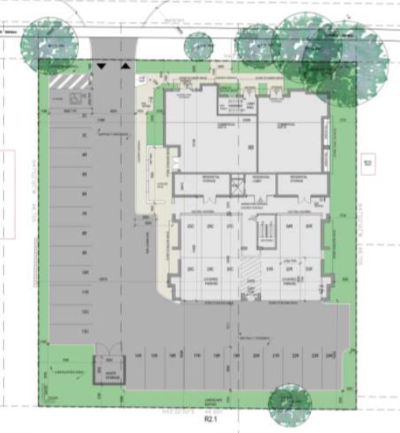 Site rendering. 10 The applicant Planner misleadingly wrote in EO item 10 (Subject; Surrounding Land Uses), and further stated under oath, that a “property at 105 Plains Rd received approval in 2013 for demolition (done) in order to construct a mixed use building, however, building permits for the mixed use building have not yet been issued. In addition, in oral, he stated that an 11 storey building was planned. This was not only misleading and untrue, but there is no such application in the City files.These statements were presented as I noted, as a surrounding land use and were taken by the Chair as a factual support for the 92 Plains proposal.
City staff said nothing to factually clarify the truth of the matter. I wrote the Planner yesterday asking for this information, which she should have, but I have not heard anything back.
11. The applicant Planner repeatedly (10 times; EO 11, 39, 54, 56, 62, 67, 72, 83, 99, 111i) and incorrectly stated, that the proposal at 92 Plains Rd was within 500 meters of the Go Train station, which is a MTSA, and therefore the site is in the Mobility Hub area having a 150 unit/ha target. He used this to repeatedly argue support for the proposal and this is misinformation used in a misleading way repeatedly.
This estimate of distance is important because of the MTSA target boundary, so I had two different distance estimates to dispute this in testimony. The first is an estimate from Google of 600 meters straight line, and a second is by car from parallel to the Go station building estimated straight down Waterdown Road to Plains RD corner light, which is about 650 meters. Note that these are straight line distances and nothing moves to the GO in a straight line from the site on 92 Plains Rd.
City staff said nothing to clarify.
12. In EO 86 the Planner rewrites the statement of the in force OP so as to remove the second of the “shall” policies wording and change it to “is intended to” with respect to maintaining the residential appearance and character of the property.
This is a frank and deliberate lie to falsify the policy statement wording. City staff said nothing.
In my view, this blows up the Planners credibility and trust. I would also cite my point 10 above.
13. In the written and spoken under oath testimony the applicant Planner committed a significant number of omissions of relevant evidence, states partial evidence resulting in misinformation, untruths such as above, fallacies such as non sequitors, false dilemmas, begging the question or circular arguments that have the conclusion wanted based in the premises, and others beyond this space.
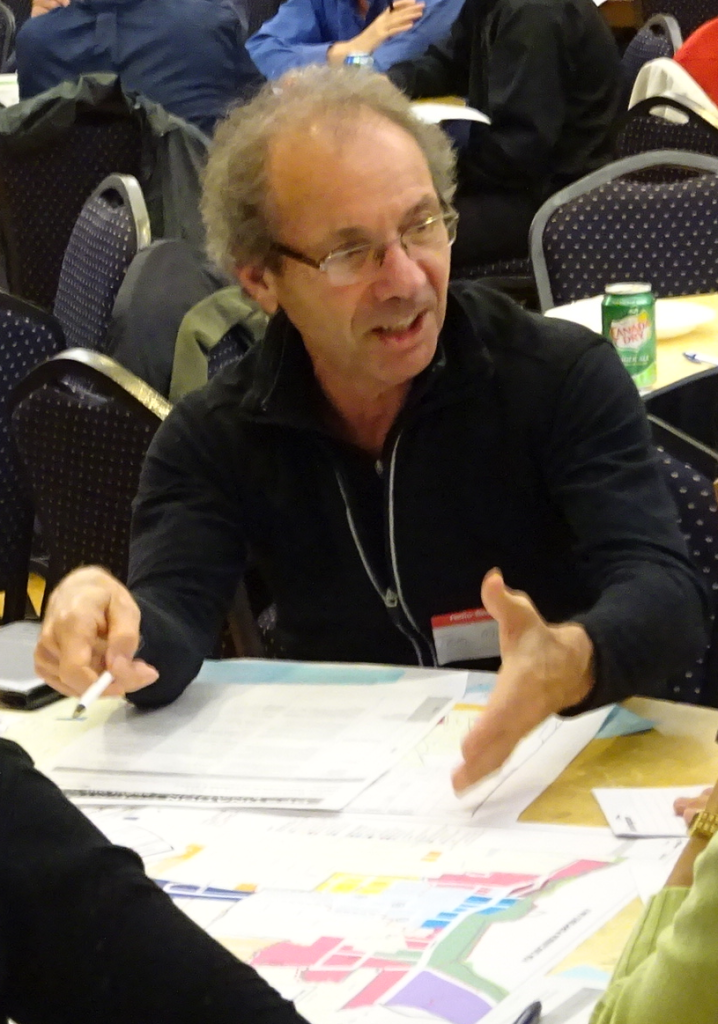 Tom Muir making a point at a community meeting. I have written more here than I expected and there are many more points I could cover. I will also say that the City staff, and the applicant Planner, having professional and disclosure duties associated with the law and planning professions and oaths of office, could have helped me and the Hearing and Chair, with getting to the truth and the facts, but they chose to remain silent and not assist in this.
What was clearly wanted, and certainly delivered, was a set of OP and Zoning amendments that is custom made to fit the settlement proposal. What the real plan or truth is has nothing to do with it.
In conclusion, I will say again that this settlement will have implications and consequences as a precedent setting model for what is to be willingly enabled, permitted and allowed in Burlington. It will be carried into whatever size you want to think of everywhere.
This is where your new Plan is going. “Ye who enters here, abandon all hope.”
Tom Muir is an Aldershot resident who knows more about Development Charges and far more than anyone should know about development in the western end of the city.

 By Pepper Parr By Pepper Parr
October 9th, 2019
BURLINGTON, ON
Figure this one out.
There is a development proposed for some of the property on the land between Lakeshore Road and Old Lakeshore Road – referred to as the “football”
 The first of two 24+ storey structures planned for the “football”. The development is controversial.
The city sent out a notice with the following note:
updated supporting documents
Application received – September 13, 2019
Then there is a list of the supporting documents.
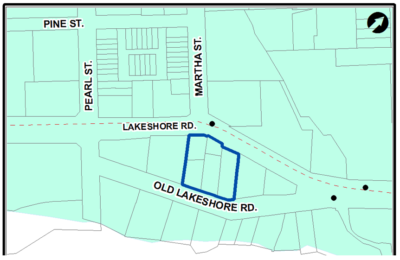 The property to the right of the CORE development (outlined in blue) also has a 24+ development proposal, • Arborist Report
• Architectural Plans
• Construction Management Plan
• Construction Management Plan 2
• Construction Management Plan 3
• Environmental Site Screening Checklist
• Functional Servicing and Stormwater Management Report
• Geotechnical Investigation
• Grading and Site Servicing
• Heritage Impact Statement
• Landscape Concept Plan
• Noise Impact Study
• Pedestrian Wind Study
• Phase I ESA
• Phase II ESA
• Planning Justification Report
• Reliance Letter
• Remediation Plan
• 7th Floor Amenity Plan
• Shoring and Excavation Plan
• Site Plan
• Sun Shadow Analysis
• Survey
• Transportation Impact Study
• Urban Design Brief
• Waste Management Plan
No mention of which document was updated or what part of the document was revised.
The Planner on the file, Melisa Morgan, will know what and where the updates are – could she not have shared this information?
This sort of thing happens again and again – and is accompanied by that bit of tripe that talks about an engaged city.
Related news stories:
CORE public presentation
Old Lakeshore Burlington Inc. development.
There are other options.
Salt with Pepper is the musings, reflections and opinions of the publisher of the Burlington Gazette, an online newspaper that was formed in 2010 and is a member of the National Newsmedia Council.

 By Pepper Parr By Pepper Parr
October 4, 2019
BURLINGTON, ON
If you spend any of your time on the kind of development that is taking place in Burlington, you will have heard about this matter before.
Every development application includes material on how the application complies with PPS 2014 – Provincial Policy Statement.
The document is part of the Planning act which governs everything that gets done when it comes to developments.
The PPS gets updated from time to time. That time is upon us now.
In a recent media release the province announced that it is open for feedback and comment from the public.
Here is what the provincial government wants to change in the PPS.
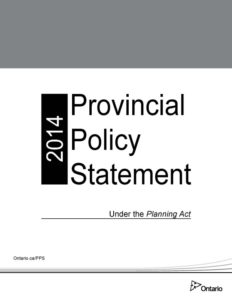 Increasing housing supply, supporting jobs and streamlining development approvals are top priorities for the government. The Action Plan includes a series of distinct but coordinated initiatives to address housing supply, including a review of the Provincial Policy Statement (PPS) – the foundation for land use planning in the province. Increasing housing supply, supporting jobs and streamlining development approvals are top priorities for the government. The Action Plan includes a series of distinct but coordinated initiatives to address housing supply, including a review of the Provincial Policy Statement (PPS) – the foundation for land use planning in the province.
The government is consulting on proposed changes to the Provincial Policy Statement to support the government’s Housing Supply Action Plan and other land use planning related priorities.
About the Provincial Policy Statement
The Provincial Policy Statement is a consolidated statement of the government’s policies on land use planning and is issued under section 3 of the Planning Act. It applies province-wide and sets out the provincial policy direction for:
The efficient use and management of land and infrastructure
Ensuring the provision of sufficient housing to meet changing needs, including affordable housing
Protecting the environment and resources including farmland, natural resources (e.g., wetlands and woodlands) and water
Ensuring opportunities for economic development and job creation
Ensuring the appropriate transportation, water, sewer and other infrastructure is available to accommodate current and future needs
Protecting people, property and community resources by directing development away from natural or human-made hazards – such as flood prone areas
The PPS is the primary provincial land use policy document guiding municipal decision-making. The Planning Act requires that decisions on land use planning matters be “consistent with” the PPS
Municipalities are the primary implementers of the PPS through policies in their local official plans, zoning by-laws and other planning related decisions.
Proposed Policy Changes
The government is proposing policy changes to:
Encourage the development of an increased mix and supply of housing
Protect the environment and public safety
Reduce barriers and costs for development and provide greater predictability
Support rural, northern and Indigenous communities
Support the economy and job creation
1. Increasing Housing Supply and Mix
The proposed draft policies for consultation would:
Increase land supply requirements municipalities must meet:
Increase planning horizon from 20 to 25 years
Increase housing land supply from 10 to 12 years
Allow higher minimum requirement for serviced residential land (5 years) for upper- and single-tier municipalities
Update provincial guidance to support land budgeting (i.e. Projection Methodology)
Increase flexibility for municipalities related to the phasing of development and compact form
Add flexibility to the process for settlement area boundary expansions (e.g. allow minor adjustments subject to specific tests, highlight that study requirements should be proportionate to the size/scale of development)
Require transit-supportive development and prioritize intensification, including potential air rights development, in proximity to transit, including corridors and stations
Support the development of housing to meet current and future housing needs, and add reference to housing options
Support municipalities in achieving affordable housing targets by requiring alignment with Housing and Homelessness Plans
Broaden PPS policies to enhance support for development of long-term care homes
2. Protecting the Environment and Public Safety
The proposed draft policies for consultation would:
Enhance direction to prepare for impacts of a changing climate
Enhance storm water management policies to protect water and support climate resiliency
Promote the on-site local reuse of excess soil
Maintain current policies related to natural and human made hazards which directs development away from hazardous areas including flood-prone areas in order to protect public health and safety, while work by the Special Advisor on Flooding is underway
Maintain current policies that require municipalities in southern Ontario to identify natural heritage systems, and provide flexibility as to how to achieve this outcome
Maintain protections for the Greenbelt
3. Reducing Barriers and Costs
The proposed draft policies for consultation would:
Require municipalities to take action to fast-track development applications for certain proposals (e.g. housing)
Allow mineral aggregate operations to use rehabilitation plans to demonstrate that extraction will have no negative impacts
Align policies and definition of cultural heritage with recent changes to the Ontario Heritage Act
Refocus PPS energy policies to support a broad range of energy types and opportunities for increased energy supply
Direct large ground-mounted solar facilities away from prime agricultural and specialty crop areas
Make minor changes to streamline development approvals and support burden reduction
4. Supporting Rural, Northern and Indigenous Communities
The proposed draft policies for consultation would:
Allow flexibility for communities by clarifying perceived barriers to sewage and water servicing policies for lot creation and development in rural settlement areas
Enhance municipal engagement with Indigenous communities on land use planning to help inform decision-making, build relationships and address issues upfront in the approvals process
Enhance agricultural protections to support critical food production and the agricultural sector as a significant economic driver
5. Supporting Certainty and Economic Growth
The proposed draft policies for consultation would:
Encourage municipalities to facilitate conditions for economic investment, and at the time of official plan review or update, assess locally-identified employment areas to ensure designations are appropriate
Provide municipalities with greater control over employment area conversions to support the forms of development and job creation that suit the local context (current and future)
Provide stronger protection for major facilities such as manufacturing and industrial uses where non-employment uses are planned nearby (i.e. buffering uses from new sensitive uses).
Do the proposed policies effectively support goals related to increasing housing supply, creating and maintaining jobs, and red tape reduction while continuing to protect the environment, farmland, and public health and safety?
Do the proposed policies strike the right balance? Why or why not?
How do these policies take into consideration the views of Ontario communities?
Are there any other policy changes that are needed to support key priorities for housing, job creation, and streamlining of development approvals?
Are there other tools that are needed to help implement the proposed policies?
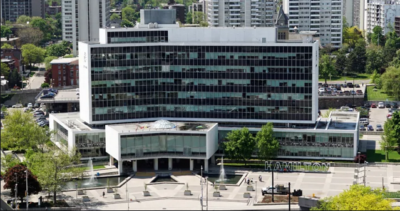 Excerpted from CATCH (Citizens at City Hall), a citizen’s report on what takes place at Hamilton’s city hall Excerpted from CATCH (Citizens at City Hall), a citizen’s report on what takes place at Hamilton’s city hall
Hamilton has submitted its concerns with the changes to the PPS – no word on what will come out of Burlington’s city hall.
Hamilton city staff are challenging yet another massive rewrite of planning rules by the provincial government. Planning staff oppose the province’s proposed elimination of policies to fight climate change and protect sensitive natural areas. They are also questioning “market based” changes that will make it easier for developers to pave over farmland and effectively shift planning approvals “from a municipal-led approach to a developer-led one.”
Municipalities are facing a major revision of the Provincial Policy Statement (PPS), the document which sets out the overriding rules that all land use planning in Ontario “must be consistent with”. The PPS directs policies on housing, infrastructure, transportation, economic development, aggregate extraction, land servicing arrangements and other municipal activities.
The province’s new rules on climate change are limited to preparing for its “potential” impacts. The Hamilton staff response going to councillors this week argues this “suggests uncertainty and does not acknowledge that impacts from climate change are already occurring”. Noting the city declaration of an emergency, they are even blunter about the provincial removal of all directions to prevent climate change.
“There are no policies within the document which speak to the importance of taking measures now to prevent or avoid climate change,” declares the staff report. “Seeing as the fight against climate change is a race against time, and actions need to be taken immediately to prevent irreversible impacts from climate change, it is an omission in the policies to not include direction to fight and prevent climate change at both the provincial and local levels through a variety of actions.”
The report also demands the province remove a new policy that “would allow mineral aggregate extraction to take place in certain natural heritage features where not previously permitted.” It further challenges wording changes that would base quarrying approvals on promises to rehabilitate in the future rather than the current requirement to review them “based on the ecological value and significance” of the affected landscape.
Other changes to the PPS centre development decisions on “market-based need” and “market demand”, terms which staff believe could “result in maintaining a market ‘status quo’ that is primarily based on a perceived desire for low density housing and will do nothing to encourage a shift to an urban form that is based on increased density.” The staff review notes that “market need and market demand are subjective terms” and asks who will define them and how that definition will be determined.
In numerous instances the word “shall” is being replaced by “should” in the PPS. Staff characterize this as policy being changed from “required” to “suggested” which gives developers more opportunity to overturn council decisions during appeals to the provincial planning tribunal.
Municipal comments on the PPS changes can be submitted until October 21.

 By Staff By Staff
October 2, 2019
BURLINGTON, ON
On August 19, 2019, the Amica people along with their financial partner Bruce Partners submitted a revised development proposal which includes 17-storey and 12-storey building elements with a 6-storey lower building podium, transitioning down to a 2-storey element for a portion of the rear of the building. The number of proposed senior’s living units has been decreased from 475 to 419.
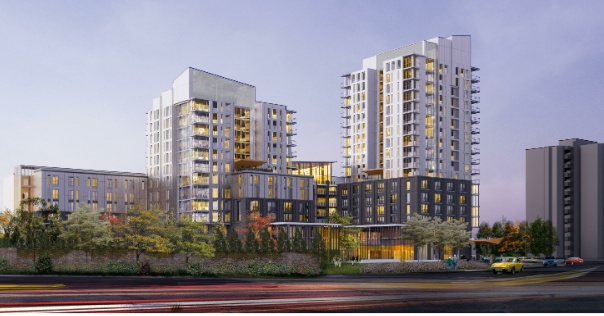 The development is at the intersection of North Shore Blvd and the ramp to the 403. Then on September 23, 2019, the Official Plan amendment and Zoning By-law amendment applications to facilitate the proposed development were appealed to the Local Planning Appeals Tribunal (LPAT).
Amica appealed the applications based upon the lack of a City decision on these applications within the legislated timeframes, as set out by The Planning Act.
The site is within the City’s Interim Control By-law area, and as such, no recommendation reports have been brought forward for development applications in this area until such time as the Interim Control By-law is lifted and policy and zoning are in place.
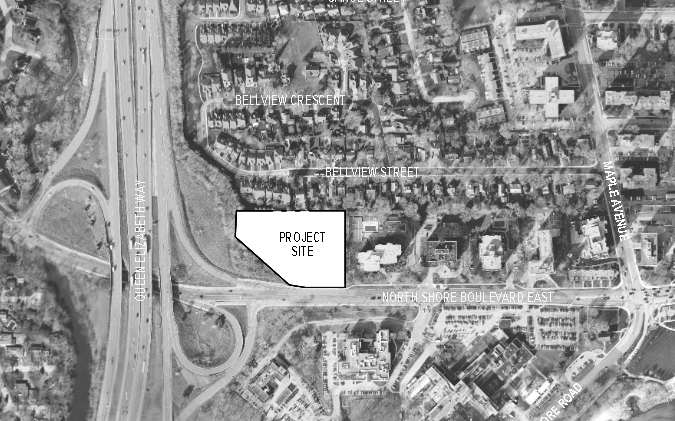 Where the development is to be located. 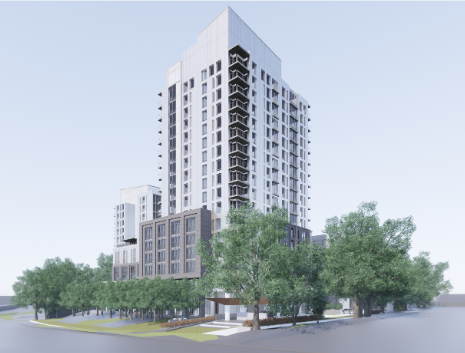 A rendering of the view of the development from the south east corner. 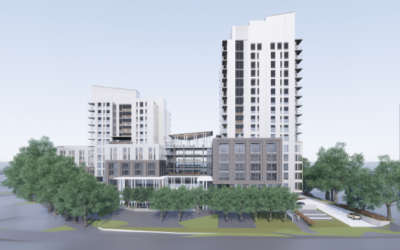 The elevation from the south. One Burlington resident is concerned that the automatic appeal that arises from the city’s lack of decision is really just a fait accompli for the development.
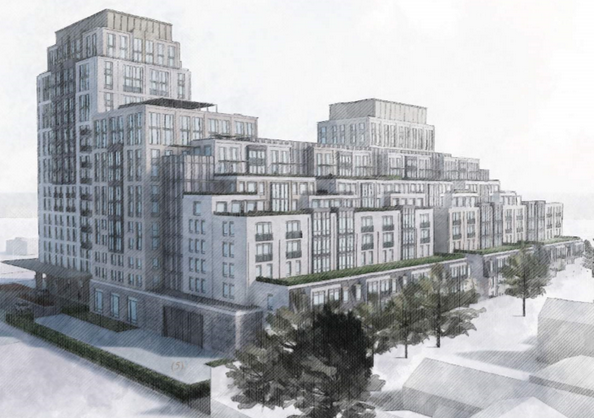 An early rendering of what the site would have looked like to the people on the adjacent street. “It will eventually pass because LPAT has jurisdiction and the city’s interim bylaw to halt development is nothing but an illusion of trying to do the right thing. If the city does nothing more than not make a decision, they are allowing developers to proceed in absentia.
The only plus in all that at this point is the revised plan is not as brutal to the eye as the first one.
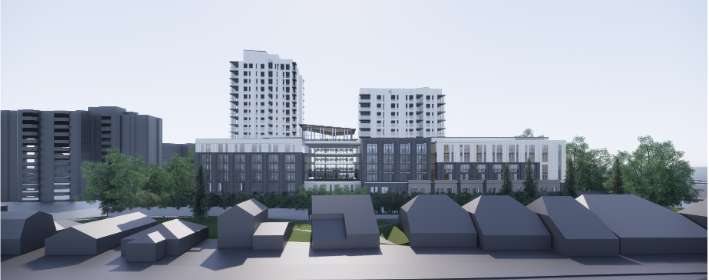 The revised elevation in the latest version of the Amica development. 
 By Pepper Parr By Pepper Parr
September 30th, 2019
BURLINGTON, ON
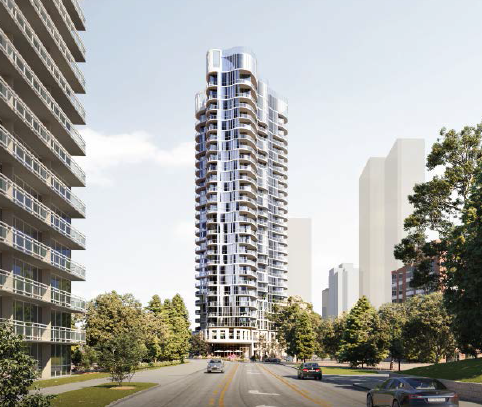 The view of the as yet unnamed tower as you drive into Burlington from the east. Mayor Marianne Meed Ward left the meeting before it ended. A presentation was being made by Old Lakeshore Burlington Inc. who were explaining what their development proposal idea was for the property at the east end of where Old Lakeshore Road and Lakeshore Road was going to look like; she had heard all she needed.
A part of the city that she used as the rallying cry for her election to city council in 2010 was about to be turned into something similar to what Toronto did to the land south of the Gardner Expressway and Lake Ontario. It was not what she had in mind for her city.
 This was the limit Marianne Meed Ward was calling for in the 2010 election. The provincial government approach to development changed when Doug Ford came into office, the massive change in what LPAT (Local Planning Authority Tribunal) was going to do for the municipal sector wasn’t helping.
Was there a way out of or around what was heading our way?
There might be.
At this risk of using a phrase that didn’t actually resonate in Burlington – it is time to be bold. Let’s try – “Daring to be a Daniel” instead.
There is in the municipal world a number of tools that can be put to very good use – but it does require some creativity.
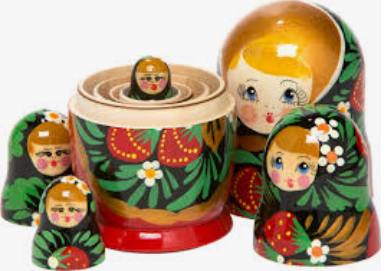 A doll within a doll – a planning tool within a planning tool. I spoke to a number of people about what the city is up against and got some solid feedback. One resident, long in the tooth and the holder of much wisdom and experience in matters related to planning, suggested the approach the city could take is a little like those Russian nesting dolls.
All these planning and land management tools can be made to fit into each. It takes very tight strategic thinking and you’re going to need a lot of that high priced legal talent to make it all happen – but they experts we spoke to told us it could perhaps be done.
Is it worth the risk to take a shot at it?
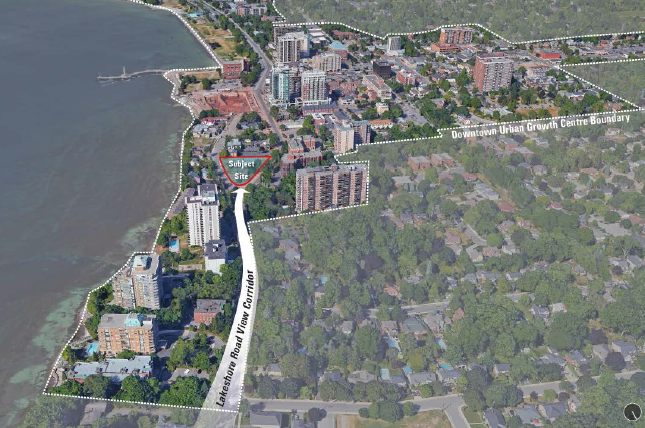 The developer sees the 26 storey tower as the eastern gateway to the city – it’s impressive. Is it the best thing for the city? There is currently an Interim Control Bylaw in place for the Urban Growth Centre. It has about eight months left in the first year it is going to be in place. The city could extend that bylaw for a second year.
The Chief Planner Heather MacDonald has a team of consultants working with her on what the city might do in terms of the kinds of development that will be permissible.
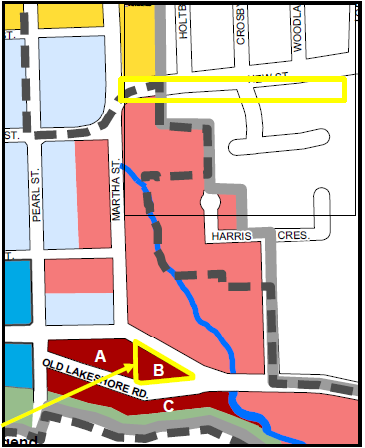 The A and B properties are in what is called the “football” The “football” is within that Urban Growth boundary – so nothing is going very far until that interim bylaw is lifted.
What I learned in my talks with a number of people is this:
The review of the adopted – but not yet passed by city council Official Plan, could designate certain lands as having a special interest for the city in terms of the long range development.
They could put what is known as an H designation – a HOLD on what gets done with a piece of property.
With that hold in place the city has time to re-think where it wants to go.
 Former Toronto Mayor David Crombie talking to Mike xxx, who at the time was President of the Save our Waterfront group that had 1000 members, With that time available Burlington can then form a group that studies the potential for the “football”; former Mayor David Crombie suggested to the Waterfront Advisory Committee that was in place at the time that they do just that. He added that putting a couple of “oddballs” on such a committee is always a good idea.
I learned that there is also a Community Improvement section in the Municipal Act – it is sometimes referred to as a Community Development Plan.
That part of the Act could be used to put together a plan that had wide wide stakeholder involvement. These plans, I was told, give a municipality a tremendous amount of power and scope – they are in effect putting the needs and interests of the citizens first.
Right now the Planning department is dealing with a development application, which they have to accept and issue a report on. They don’t have anything to compare it to – something that might be better for the city.
If the buy in from the public was high enough the city could move to expropriate all the land within the “football” and float a bond to pay for it.
If the Mayor wanted to get really creative she could look for a way to create a bond that the average citizen could units of.
 Does the Mayor think there is a way out of what the developers have told us they want to do with the football? Will the Mayor manage to toss it back to them and expropriate the land. Meed Ward is staring at a couple of developments that will put 26 storey condominiums on land she believes should not be any higher than 12 storeys.
LPAT will not let that happen – the developers know they will win at that level.
There just might be a way to do something truly stunning for the city.
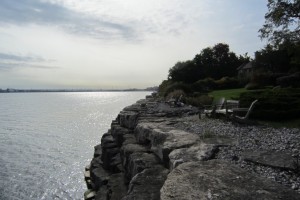 All of this was close to given away to the owners of properties that abutted the waterfront. That terrible loss the city suffered when lake front land between Market and St. Paul was sold for a pittance can’t be reversed – but amends could be made for that loss.
Emma’s Back Porch and the Water Street Cookery could be part of something truly unique.
All it takes is takes innovation, creativity and courage.
We are far from experts in this field. But we do believe that citizens will stand up for themselves when the leadership they want leads.
The 2006, 2010 and the 2014 city council’s didn’t lead. Mayor Meed Ward has made it clear things will be done differently – how much differently.
Let’s see where the Gazette’s active comment people have to say.
Salt with Pepper is the musings, reflections and opinions of the publisher of the Burlington Gazette, an online newspaper that was formed in 2010 and is a member of the National Newsmedia Council.

 By Pepper Parr By Pepper Parr
September 27th, 2019
BURLINGTON, ON
The Mayor stood at the back of the room, glumly listening to a development presentation that, if ever built, would crush the agenda she has had in place from the day she first began to be politically active in ward 2 where she became the Council member, served two terms and went on to get elected as Mayor.
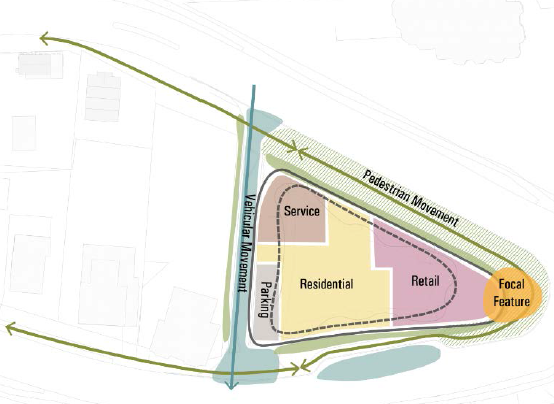 Design concept principles. The development is in a prime location – at the visual entrance to the city as one drives in from the east.
The shape of the property gave the developer the opportunity to do something stunning and Nick Carnacelli didn’t disappoint.
 Looking at the development as you drive into Burlington from the east. The design is stunning, it sets a new benchmark for excellence in outside appearance and will certainly draw the clientele that can afford what it is going to cost.
The only problem was – no one liked the height – they wanted something lower.
Time may prove that lower buildings will become possible in Burlington but the evidence at this point is that height is a given – the issue will be where that height gets situated.
The city had more than a decade to make it clear that it had different ideas for what it referred to as “the football” because of its shape – enclosed by Lakeshore Road and Old Lakeshore Road and limited to some degree by the set back and top of bank requirements along the lake which is yards away from this development and the one proposed next to it.
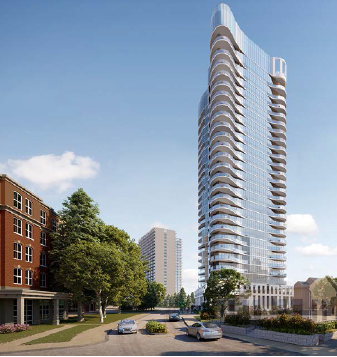 Looking west along Lakeshore Road, Martha’s Landing is on the left. The meeting began with Andreas Houlios, a city planner setting out what the zoning was and what the Official Plan that is in place permits. Burlington has an Official Plan that was put in place in 2008.
A new plan was passed by city council in 2017 but not approved by the Region.
The 2018 election brought in a new council that took what they called an “approved” Official Plan and began the process of revising it. The city is waiting for that revision to be made public as soon as it is complete. But right now, today – the Official Plan as it will apply to this development reads like this:
Official Plan designation:
• Downtown Mixed Use Centre
• Old Lakeshore Rd Mixed Use Precinct (Area B – East Sector)
Site Specific Official Plan Policy:
• Building heights up to 10 storeys and 31.5 metres
• Taller building heights up to 12 storeys and 37 metres permitted subject to certain requirements
Subject Site
 What is permitted on this site? What is permitted on this site?
Current Zoning:
• DL-A (Downtown Old Lakeshore Road)
• Permits a variety of retail and service commercial uses, office, hospitality, entertainment and recreation uses, as well as apartment buildings and retirement homes.
• Maximum height of 10 storeys -12 under certain situations.
• The Provincial Planning Act allows applications to be submitted at any time by landowners to change the Official Plan designation and/or zoning on a property.
• The City is required to process these applications following a set of Provincial rules and regulations and with consideration being given to existing Provincial and Regional policy.
• City planners obtain technical advice and public input before making a recommendation to Council.
• If Council does not make a decision on an application within the legislated timeframe, the applicant may be appeal the applications to the LPAT, if desired.
And that is what the developer has done. They are asking for a change to the Official Plan and changes to the zoning on the site.
The property happens to be within the boundaries of an Interim Control Bylaw (ICBL) that is currently in place for one year – that year has about eight months left.
 The development will dominate the entrance to the city. The Planning department will receive the application but will not begin a Staff Report until the ICBL is lifted.
With that background in place the audience of about 40 people got to hear what NAME had to say about the merits of the development. He did not get a round of applause and he was interrupted a number of times.
Mark Bales, a vice president with the developer Old Lakeshore Burlington Inc., stood a few times to elaborate on a point and to answer questions from a less than friendly audience. Mr. Bales at one point chose to hold his open hand up facing Councillor Lisa Kearns in an effort to stop her from speaking – an atrocious bit of behavior that we have seen before.
Nick Carnecelli, standing at the back of the room signaled to Bales to tone it down.
The audience the developer was dealing with did not want what was being proposed – they wanted the 12 storeys the Official Plan permits.
There were some ideas put out on how traffic might be managed and the wish for a more “village like” setting. Nothing the developer was going to do anything with.
It is now a waiting game until the ICBL is lifted.

 By Pepper Parr By Pepper Parr
September 26th, 2019
BURLINGTON, ON
There is a meeting taking place this evening at the Central Arena, on Drury Lane road, across the street from the YMCA.
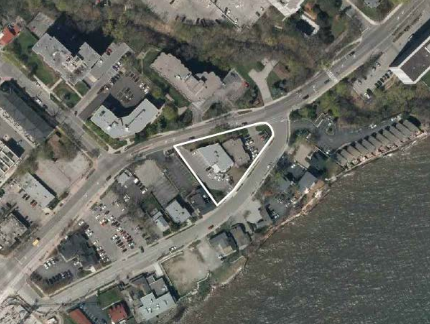 The public will get a look at what the developer wants to do with the southern end of the “football” the land between Lakeshore Road and Old Lakeshore Road. It is a pre-consultation meeting, a non-statutory meeting to obtain community input on all of these elements prior to the submission of an application. Planning staff will be in attendance to provide information on the development application review process and next steps. The owner and consultant team representatives will also be in attendance to listen and collect ideas and input from the community.
Old Lakeshore Burlington Inc. is the owner of lands located at 2107-2119 Old Lakeshore Road. The City’s current policies provide for the potential development of a tall building of up to 12 storeys on these lands. The owner is currently considering the redevelopment of the lands with a mixed-use tall building of up to 26 storeys.
This is the way development takes place in Burlington.
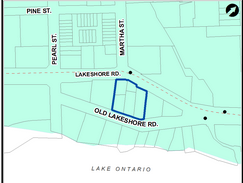 The properties the CORE development group want to put 26 storeys on. A number of months ago there was another such pre-consultation public meeting. This one was at the Art Gallery. It went through the same process; there weren’t a lot of people in that room with much in the way of appetite for the development. The developer in that case was the CORE group.
When the Gazette asked for a copy of the presentation made by the developer – they promised to send it along the next day, we are still waiting for that one.
 A 3D model of what the south eastern core of the city would look like if the CORE development on the table is approved and built. Another developer wants to build a high rise at the eastern end of the Lakeshore and Old Lakeshore intersection. Both developments, the CORE development and the Old Lakeshore Burlington development, are in the same part of town – what is sometimes referred to as the “football” – referring to the shape of the property that exists between Old Lakeshore Road and Lakeshore Road.
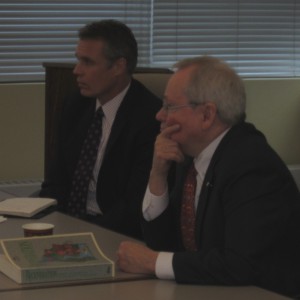 Former Mayor Rick Goldring sits beside former Toronto Mayor David Crombie to listen to members of the Waterfront Advisory Committee. A number of years ago, when there was a Waterfront Advisory Committee chaired then by Nick Leblovic they invited former Toronto Mayor David Crombie to talk to them about how development can be managed so that the wishes and the will of the public are at least heard. Crombie at the time said: You need to put together a committee and ensure that you have a couple of oddballs at the table – they are the people that pop out the interesting ideas.
Then Mayor Goldring sat in on that meeting; nothing ever came of the idea. Sometime later the Waterfront Advisory was put to rest.
Any development ideas were going to come from the development community. And that is what we are looking at today.
The very significant sized developments that abut each other on what is now the most valuable developed land near the lake, across from Emma’s Back Porch and a football field length away from the Bridgewater development which appears stalled.
There is no public protesting; there is no group formed to suggest that this is not the way this part of the city should be developed.
Other than saying the city doesn’t want this type of growth in this part of the city Mayor Meed Ward hasn’t said very much.
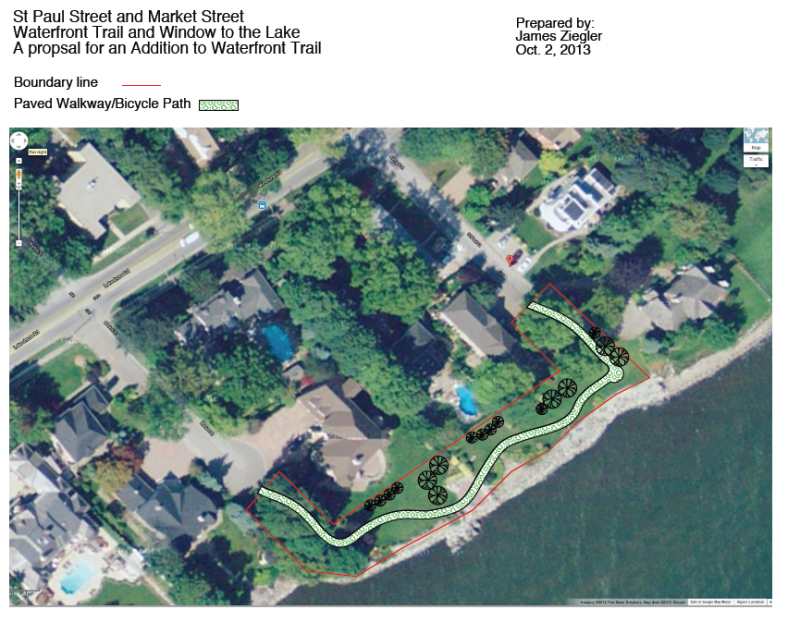 All the land within the red outline was public. The city went along with the sale of the pieces in the middle that abutted houses – they kept the piece of land at each end and turned them into Windows on the Lake. A Crown Jewel had been sold. Burlington lost the opportunity to keep a large part of the waterfront in public hands when it went along with the sale of that land between Market and St. Paul.
Meed Ward, as a Councillor fought a valiant battle to maintain ownership of that property – despite her efforts then, Crown Jewels were sold for a pittance and the province got most of the money.
George Santayana, a noted philosopher, essayist, poet, and novelist who once appeared on the cover of Time magazine wrote that: “Those who cannot remember the past are condemned to repeat it.”
It is going to take a lot more than people who attend the meeting this evening saying this is not what the city wants – it is going to take real leadership – not from just the Mayor but from every member of council.
 This is the crowd that is going to have to step up, get creative, be bold and find a better way to develop the land in the “football”. Time for the newbies to step up to the plate – let’s see what you are made of.
Salt with Pepper is the musings, reflections and opinions of the publisher of the Burlington Gazette, an online newspaper that was formed in 2010 and is a member of the National Newsmedia Council

 By Pepper Parr By Pepper Parr
September 26th, 2019
BURLINGTON, ON
A number of weeks ago the Gazette had an email conversation with city manager Tim Commisso who wrote about some of the changes that would be taking place at city hall.
He mentioned at the time that he had 17 direct reports and that he wanted to reduce those considerably so that he could concentrate on the development of a strategy that would fill the direction he was given by council back in February.
Yesterday Commisso put his plan on the table during a closed session of council. The new organizational structure was adopted by Council during the closed session – the public got word of it when they put out a media release. We have absolutely no idea what council thought of the plan – did they ask for changes? Was there a vigorous debate?
The plan looks to be solid. The Gazette learned from a former senior staff member that it was a “plan that should work”.
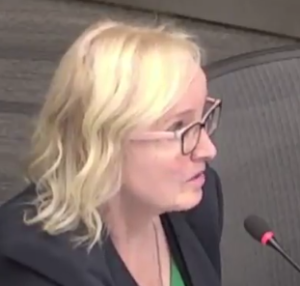 Director of Human Resources Laura Boyd We asked Commisso if the Burlington Leadership Team would continue to operate; recall the Director of Human Resources Laura Boyd wrote in her exceptionally revealing report to council back in July said:
“When the results were further analyzed, it became apparent that communication within the organization diminishes between hierarchical levels.
“Specifically, between the Burlington Leadership Team and the Supervisors/Manager level and then between the Supervisors/Managers level and their direct reports.”
Commisso told us that the “city’s internal leadership/strategic management structure will still encompass: Exec Directors, Directors (Department Heads) and City Mgr. BLT will meet weekly and provide strategic management oversight on day to day City service delivery, review of upcoming Council reports, implementation of Council V2F work plan and other corporate projects. BLT also deals with city policies and procedures, budget development, ongoing council/ staff relations.
He added that “The Strategy and Risk Team (SRT) will meet biweekly and will focus at a more detailed level on corporate strategy execution and related risk mitigation and also reporting on same to Council on a regular basis. SRT is a new leadership team comprised of Exec Directors and City Mgr. SRT will also focus on corporate wide business processes such as customer service, health and safety.
Commisso said “This approach is a best practice for municipal and public sector governance” and added that “We will need to align the new structure with Council’s standing committees and are working on a report to Council on that for Oct.
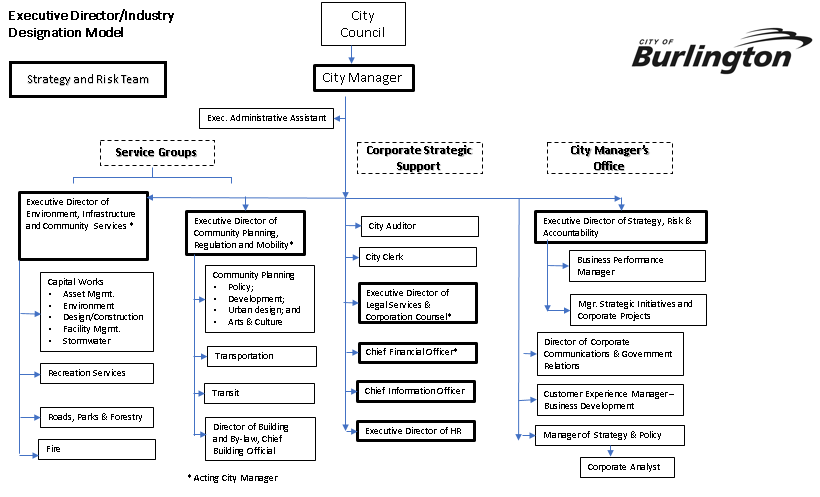 The Gazette wondered aloud during a telephone conversation earlier today if this organizational change was not a consolidation of power in the city manager’s office. Commisso doesn’t see it that way. He did reduce the number of direct reports from 17 to 12 and admits that even twelve is a little on the high side. The Gazette wondered aloud during a telephone conversation earlier today if this organizational change was not a consolidation of power in the city manager’s office. Commisso doesn’t see it that way. He did reduce the number of direct reports from 17 to 12 and admits that even twelve is a little on the high side.
One of the problems Commisso has is the quality of his bench strength – there are a number of senior people not exactly pulling their weight – at the same time there are a significant number of young people who have done well but find it difficult to see Burlington as a place where they can grow meaningful careers – there have been four city managers in a six year period.
You build a team by ensuring that management stability is in place and that it is going to be there for some time and that there will be opportunities for professional growth.
Getting the new organization in place has been a huge task for Tim Commisso; he loved doing the work – says he loves the city. He’s not a talkative man – without ever having had an opportunity to sit opposite the man it’s difficult to get the measure of him.
Our conversation with him on Wednesday was short – he was swamped.
We wanted to ask: Is this just round one of the blood letting at the staff level. It would have been inappropriate of him to respond but the question remains. Many of the keen observers of city hall matter don’t feel the job has been completed.
Strategy is just one part of what Commisso believes has to be put in place. The other is a change in the culture – that one is going to take years – it will have to start soon for staff to buy into it and then years to make changes and make them stick.
Can MacDonald and Magi instill a different more meaningful sense of confidence in staff? Does Human Resources have a handle on just what the problems are and perhaps some solutions as to how to give the place a shot of something?
The Gazette recalls a citizen who once worked at city hall in a very senior job where he was right in the thick of it all. He gave some thought to running for office – actually came close to deciding he would and then decided that it was “too toxic” (his words) and left the public office job to others.
While Commisso can perhaps pull rabbits out of hats (that is not a skill set he lays any claim to) he has to cope with a city council that does not yet have a full year under its belt.
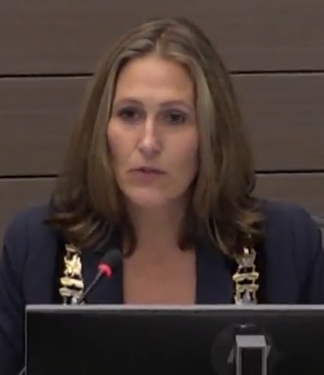 Mayor Meed Ward fully understands the power she has when she wears the Chain of Office. Can her colleagues restrain her? They have done just that a few times. He has to deal with a Mayor who has an agenda and she is certainly pushing that agenda. If he doesn’t have a real concern over how reserve accounts are handled – then he should have. He needs to find a way to counsel the Mayor and educate the newer council members on why we have reserves and the way they should be handled. All five of the newbies have turned to the city manager for advice and direction – when their job is to hold the man they are turning to accountable.
Commisso didn’t think that was a problem. The governance people we spoke to told us that it was a serious problem and that Commisso was walking on this ice.
The mention that Burlington is one of the best places to work just isn’t true. The chaos is disturbing.
With Heather MacDonald and Allan Magi serving now as the management level directly beneath the city manager there is a line of authority and direction that has been missing for some time.
 Heather MacDonald, now one of the two leaders working with the city manager to make it all come together in conversation with a citizen at a public meeting. It is going to take a bit of time for the two to get the hang of the job. MacDonald came to Burlington a relatively short time ago to serve as the Planning Director and now finds herself as responsible for the effective administration of a much bigger plate. She was doing just fine with the Planning problems; the Interim Control Bylaw was hers to oversee as well as the re-writing of the Approved Official Plan.
Behind all that there is the pile of development applications that are going to flood the city when the Interim Bylaw gets lifted. There is a lot of work on that table.
Two new positions have been created:
Customer Experience Manager-Business Development
Executive Director of Strategy, Risk and Accountability
They will both be posted on the city’s web site and be open to outsiders.
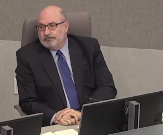 City manager Tom Commisso is often the only senior administrative person at council meetings. He says what he has to say in relatively few words. Commisso believes they are both critical – it will be interesting to see the job description when it is posted. The use of the word ‘accountability’ raised an eyebrow- just what does the city mean when they say ‘accountability’.
This is something we will return to once we see the job posting.
Related news stories:
Director of Human Resources lays it all out on the table.

 By Pepper Parr By Pepper Parr
September 12th, 2019
BURLINGTON, ON
This afternoon city council will be discussing and debating one of the biggest problems the city faces: Managing the growth.
In a story we published earlier in the month we wrote:
“Assume just two people to a dwelling (and that is quite an assumption) we are looking at between 29 and 42 thousand new dwellings.”
This was in reference to a study that was done in 2008 when the City undertook an Intensification Study to better understand the intensification opportunities in the City which could accommodate growth to 2031. It was recognized at that time that the City’s supply of Greenfield land was diminishing and a more comprehensive approach to planning for intensification was needed.
That study focused on key areas within the City’s urban area and included a site by site analysis to identify opportunities for infilling and redevelopment. This study, which laid out a general framework for longer term growth planning in the City, determined a reasonable estimate of residential units, people and jobs, which could be provided through intensification by 2031. The study also concluded that Burlington was expected to exceed the 40% intensification target in the Growth Plan that is applied Region wide.
 While taking the applause did the members of this newly elected city council have any idea how big a job they had ahead of them? The study findings were used to inform the growth analysis work that was undertaken by Halton Region through their Sustainable Halton process, which resulted in population and employment growth forecasts to 2031 as well as intensification and density targets for the City and the other municipalities in the Region.
 One of Burlington’s younger citizens uses a Lego model to explain to council just what the city will look like when the development being proposed are completed. The city is now preparing their comments and input for the 2041 growth targets, That’s where that “looking at between 29 and 42 thousand new dwellings” comes from. That is a massive number that most people are not fully aware of – the Gazette wasn’t around in 2008 – we would have alerted you.
You can watch the live webcast this afternoon.
They will be talking about your future.
Related news story:
Just how much growth is Burlington going to have to absorb?

 By Staff By Staff
September 10th, 2019
BURLINGTON, ON
Some movement at city hall on the expected application to do more quarrying by Nelson Aggregates.
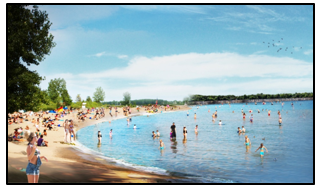 A decommissioned quarry site turned into a lake – 30 footballs fields in size. The company has been very proactive and going to some lengths to get its story out – the ward Councillor appears to have forgotten that the job is to listen to all sides of an application.
We reached out to the Nelson Aggregate people and learned that they haven’t heard a ward from Councillor Nisan.
What the Councillor has done is ask his colleagues to support his Staff Direction for the following:
Direct the Director of City Building to report back to the Planning and Development Committee on the land use development application and review process related to the proposed Nelson Quarry expansion, including but not limited to the following:
• summary of the process including decision points;
• anticipated timelines for process steps;
• roles and responsibilities of review agencies;
• a summary of process and outcomes of the previous proposal for expansion; and
• a summary of any the new provincial legislation related to aggregate resources.
All that information is currently in the public domain – If Nisan wanted some additional depth the Deputy City Manager would have told him everything he would need to know and then some.
The Staff Direction move might just be some way of Nisan saying to his constituents: ‘I’m working for you’.
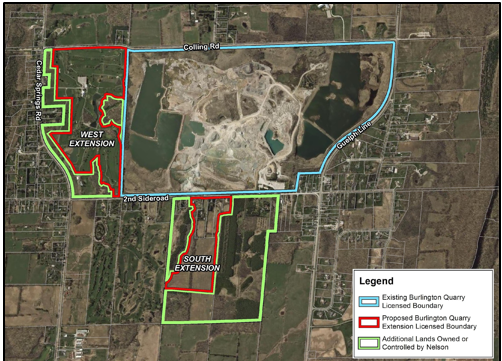 The Nelson offer is to turn all the land over to the city when they have completed the quarrying. Council appears to have taken the position that they will talk to the quarry people when the site has been decommissioned. What Nelson Aggregates is required to do in the way of decommissioning is set out in their license, which the Gazette has made public.
 Note attached the one of the Nelson Aggregates licenses. What Nelson is saying is that they have some unique ideas on what they can do with the site when they are finished that will determine just how they do the decommissioning – not whether or not they are going to do it.
Councillor Nisan will never know what they are thinking if he doesn’t talk to them.
He seems to be arming for a fight.

|
|





































































































